CONSTRUCTING A NEW PERSPECTIVE

ACT Australian of the Year

















ACT Australian of the Year















When Florence was first started five years ago the idea was simple, to construct a new perspective on women in construction.
For the past five years, and 10 editions, we’ve been telling your stories.
Stories of adversity, courage, resilience and achievement.
Through the pages of Florence we have shone a spotlight on the gamut of women across the building and construction industry — apprentices, carpenters, project managers, town planners, architects, engineers, fencers, developers, building certifiers, estimators, crane operators, plumbers, business owners and so many more.
We’ve talked about mental health, workplace harassment, health issues, attracting girls and women to the industry and retaining them, and creating real change in building and construction.
The work has just begun and we hope to continue to play a vital role in championing change for many years to come.



When we first produced the first edition of Florence five years ago we had one simple motivation — to construct a new perspective on women in construction.
In those five years, we have produced 10 editions, telling your stories of adversity, courage, resilience and achievement in this male-dominated space.
And this edition is no exception.
ACT Australian of the Year recipient Jo Farrell is one such story (p. 8). From a school leaver fighting for her right to start her apprenticeship, to fighting for her and other women’s rights to be treated with dignity and respect at work, Jo has persevered and built an amazing career that has spanned more than two decades.
Editor: Alyssa Welke
Editorial Coordinator: Amanda Kelly
Designers: Jeff Brown, Mark Stansall
Sub-editors: Jessica Kramer, Cam Ward
General Manager: Erika Brayshaw
Advertising enquiries: 0480 097 561
Editorial enquiries: 07 4690 9396
Email: alyssa.welke@news.com.au
Printed by: Greenridge Group, 4 Freighter Avenue, Toowoomba QLD 4350
News Corp Australia is the exclusive Publishing Partner of Florence magazine, in conjunction with the Master Builders Association of New South Wales.
ABN: 63 009 820 035. Ph: (07) 4599 3835
Website: www.newscorpaustralia.com
This publication is copyright. No part of it may be reproduced, stored in a retrieval system or transmitted in any form or by any means including electronic, mechanical, microcopying, photocopying, recording or otherwise without the permission of Master Builders Association of NSW or News Corp Australia. Disclaimer: The information contained within Florence magazine is given in good faith and obtained from sources believed to be accurate. The views expressed are not necessarily those of the publisher. News Corp and the Master Builders Association of New South Wales will not be held liable for any opinion or advice contained herein.
As a new mum in the 1990s, Jo Gillies, still wanted to work in her chosen field of architecture (p. 16), but many doors were closed to her because of the workload expectations at the time. But she found a way to continue to do what she excelled at and loved while juggling motherhood, and has built a thriving architecture firm that is brimming with soul.
Jessie Nasif (p. 20) has taken every opportunity offered to her to build a thriving career in building certification. Over the last 10 years she’s work her way up from working in administration to being a now being a team leader of 14 certifiers.
While each of these stories is unique in its challenges, they all have self belief and respect at their core. And all of these women aim to lift up others and make this industry better for those coming through.
We look forward to sharing another five years worth of stories with you all.
Until next time,
 Editor Alyssa Welke
Editor Alyssa Welke

Florence Taylor was a pioneer of women in the construction industry and her legacy is still being felt.
As an architect and publisher, Florence believed in the notion that “a woman to marry, get into the confines of the home and never be articulate in public affairs is a disgrace” and her achievements in the male-dominated architectural industry proves that.
She was known for her energy, determination and outspoken nature, a nature which distinguished her well throughout her colourful career, first as a draftsman and ultimately as a publisher of trade journals.
She was widely respected, even if her questions and criticism irritated some of her professional colleagues.
Her achievements within both of her fields had an indelible impact on the public acceptance of women in the professions.
She was a tall, striking woman, with blonde hair and blue eyes, and was known for dressing (even in the 1930s) in long sweeping skirts and a picture hat decorated with ostrich feathers.
She was born on December 29, 1879, at Bedminster, Somerset, England and was the eldest daughter of John and Eliza Parsons.
The family immigrated to Australia in 1884, where her father worked in the sewerage construction branch of the Department of Public Works, which gave Florence her first taste of working in the construction industry, as she assisted her father with his engineering calculations.
It was her father’s death in 1899 that pushed Florence into the architectural industry when she decided to become a draftsman to support her family.
She learned her trade under architect Edmund Skelton Garton, and simultaneously attended night-classes at Sydney Technical College until 1904.
During her time with Garton’s
office she was promoted to chief draftsman.
Once she completed her training she became chief draftsman to J. B. Clamp, who nominated her in 1907 for associate membership of the Institute of Architects of New South Wales.
Despite his defence of her talent (she “could design a place while an ordinary draftsman would be sharpening his pencil”), the nomination was defeated.
But this did nothing to deter Florence from thriving practice designing homes.
It wasn’t until 1920 that Florence was eventually invited to join the Institute of Architects, which she accepted.
On April 3, 1907 Florence married George Augustine Taylor.
Florence and her husband were founding members of the Town Planning Association of New South Wales in 1913 and she was its secretary for many years.
Together they started the Building Publishing Co Ltd, which produced trade journals, three of which Florence edited: Harmony, Young Australia and the Australian (later Commonwealth) Home.

Architect and publisher Florence Taylor; One of the periodical’s Florence published during her career.
PHOTOS: COLLECTIONS OF THE STATE LIBRARY OF NEWSOUTHWALES.
Through their journals they campaigned for urban planning, improved construction methods and better materials; they also promoted the interests of engineers, architects and builders.
When George Taylor died suddenly in 1928, Florence was determined to carry on their business and although eight of the 11 journals the business was publishing was forced to cease, she maintained Building (later Building, Lighting and Engineering) (1907-72), Construction (1908-74) and the Australasian Engineer (1915-73), and edited them herself.
She continued to produce town planning schemes but relied on others to draw them as she was unable to spare time from publishing.

The building and construction industry is one of the largest sectors in Australia. Latest statistics indicate at the end of 2023 there were 1.3 million workers across 445,000 businesses in our industry, however only 15% are female and 3% are classified as tradespeople. Small to medium enterprises represent 98% of those businesses. Our industry fuels economic growth, innovation, and job creation. For every $1 billion the industry makes, $3 billion is returned to the Australian economy.
Workplace shortages are placing immense pressure on the industry’s ability to meet housing targets, and many in the industry believe women will play a vital role in addressing these shortages.
Increased female participation has many benefits. It lifts productivity, boosts the economy, facilitates financial independence, and assists in developing an inclusive and diverse culture.
It is clear that some sectors within our industry require cultural change as well as more flexible approaches to patterns of work if the industry wants to attract and retain women. This will be an ongoing challenge.
Furthermore, the industry must do more to end the bias between universities and vocational education and young women should be given the same opportunities as their male counterparts.


knows now is the time for a cultural overhaulALYSSA WELKE
From an early age Jo Farrell loved construction. From watching intently what was happening on construction sites in her home town of Wollongong to building Lego, she gravitated towards the trade.
But her love of building and construction and her drive to be part of the industry wasn’t encouraged at school, or early in her career. In fact, she was actively discouraged away and rejected by the industry.
“When I was in Year 10 and you do your week of work experience out somewhere, at school it was really standard for all the boys to go off to the steel works because their dads and uncles and brothers and everyone worked there,” Jo says.
“They’d go off and have a taste of what an apprenticeship would look like in that way.
“I put my hand up to the careers counsellor and said ‘Well, can I go and do that too? ‘Cause I’m really keen to start an apprenticeship’. He said ‘if you want an apprenticeship, go and be a hairdresser’.
“And I kind of went ‘no, not the same thing’. It was just shut down immediately, there was no entertaining that idea whatsoever, no support.
“Mum stepped in to try and find something, and the closest she could come up with, because she worked at Wollongong University at the time, was to organise for a week at the mechanical engineering
department, which is not the same,” she laughs.
“You’re sort of just sitting in lectures about airconditioning. She did her best, but obviously not the same things.
This experience led Jo to the knowledge that she wasn’t going to be supported in her journey, but she didn’t give up.
In 1996 she finished high school and told her mother that she still wanted to get an apprenticeship. With no online job boards or websites and only rudimentary internet, this meant knocking on doors with a printed copy of her resume or looking in the newspaper for job listings.
“There were loads and loads of apprenticeships on offer but I would front up and just be told no,” Jo recalls.
“I’d barely get people to even take me seriously. I saw one guy crumple up my CV and throw it in the bin while I was still there.
“The comments were ‘we don’t employ women’, ‘girls are a distraction’, ‘you’re not going to be able to do the job’, ‘you’re not going to be strong enough’, ‘you’re not going to be able to hack it’.”
Jo estimates she went through roughly 150 companies with rejections, often turning up already knowing the answer would be no.
“It was just an automatic ‘not even going to give you a start’. It was just no and it was just purely based on gender.”
But Jo refused to let that blatant rejection stop her. She found a way to work on the periphery of construction, starting in the timber and trade department at a hardware store to get a feel for what life as a tradie was like, and eventually she was given a chance at an apprenticeship after wearing down one man.
“ I think [he] just got sick and tired of seeing me,” Jo says.
“He said to me ‘sure you can turn up, but I’m not going to pay you for three months, and if you survive then we’ll think about putting you on’.
“I’d like to think that wouldn’t happen today, but that was my only way in.”
Despite other employees making “life as uncomfortable as possible” for Jo and the apprenticeship becoming about how much she was willing to take to just keep turning up, she persisted with the battle of wills.
“It wasn’t an overly positive experience for the first two years, and I’ve had just about every apprenticeship hazing prank out there done to me,” Jo says.
“But eventually I did wear him down and I do recall when he signed my papers to get me started as a registered apprentice, he begrudgingly said ‘you know, you’re still not gonna last long in this industry’.
“This is my 28th year this year. I’d like to say I’ve had the last laugh on that front.”
But even after she finally “earned” her apprenticeship, Jo battled against gender prejudice on a daily basis.
“It was hard, I’m not gonna lie. I was made to feel unwelcome constantly. Even after a time you’d think that would wear off, but I was never part of the group. I would be sitting on my own having lunch, I was never invited to the pub afterwards for a beer. They would begrudgingly work alongside me and I’d start to learn (the trade) because I was a pair of hands willing to do the hard work, but certainly there wasn’t any acceptance there.”
Jo completed two years of her apprenticeship, but the owner of the building company she worked for went bankrupt. With no-one else in Wollongong willing to take her on to complete her trade training, she made the move to Sydney to complete her training. Fortunately for Jo, building and construction trades jobs were abundant, thanks to the 2000 Sydney Olympics. She worked on the Olympic village, working on high-rise construction work and finished her trade with two years’ experience in residential building and two years in construction.
And while there were still elements of bullying, harassment and not being accepted, things began to change.
Now, after 28 years in the industry, Jo is the ACT general manager with Kane Constructions, a leading commercial construction company with a turnover in excess of $1 billion and more than 450 full time employees.
However, change is still slow in the industry, and it is causing harm across the board.
It is this change Jo champions and wants to help accelerate through her not-for-profit organisation Build Like a Girl.
Her work in this space saw her named the 2024 ACT Australian of the Year award, an honour Jo is both immensely proud of and humbled about at the same time. She has the same feelings around winning the inaugural Construction Woman of the Year award at the Master Builders ACT Awards in 2022.
Jo says she doesn’t set out to be nominated for awards and that if a person’s intent is to simply win awards, then they’re probably focusing on the wrong reason for doing what they do.
“I get a little bit embarrassed by them,” she says.

“I look around the room and legitimately think that other women deserve it more than me. That’s not just me trying to have hubris or an extra level of humility, it’s just the fact that that was never the intention. I don’t do anything I do [to receive awards] and it’s lovely to be acknowledged across the spectrum with that.”
Jo describes the Australian of the Year award as a once-ina-lifetime opportunity, with a week spent staying with the other finalists, meeting the Prime Minister, and going to the Governor General’s house. The other finalists were “spectacular people”, she explains, and all humbly focusing on doing good things for other people in the community.
“When you spend a week with people like that, it is quite a humbling experience and you get re-energised from their energy and their passion from what they do,” she says.
With renewed energy, Jo is turning her focus to the important work she started when she founded Build Like a Girl in August 2020, with a vision that every woman, regardless of age, ethnicity, income level or social status, can freely choose and enter into a trade apprenticeship in the building and construction industry.

Through this, Jo wants to implement real change in the building and construction industry by coordinating programs for women-in-trades across Australia together in one holistic movement.
After hearing countless stories of young girls and women being turned away from apprenticeships and jobs in the industry, she’s had enough.
“There were all these different scenarios and I just started getting really angry about it,” Jo says.
“I thought ‘it’s been two-and-a-half decades of me having to face and overcome those challenges and are you telling me in 25 years we haven’t made any changes to make this easier, more accepting for women?’.
“And the stories just kept coming and coming and coming and so I sat down at my dining room table one weekend and went ‘how do I fix this?’. That’s how Build Like a Girl was born.
“It’s pure rage of other women having to endure and go through what I’ve been through and all of the things that I could put in place to try and combat that and address it. I ended up cajoling some people into helping me set up a not-for-profit, which is harder than it sounds, and pulling something together.”
As well as helping women find employment in the industry, Build Like a Girl works with peak bodies such as Master Builders, Civil Contractors Federation, and many others.
As founder of Build Like a Girl, Jo uses her “spare
time” to talk to employers and educate them on what employing women actually means and that it isn’t a scary proposition.
As well as being a grassroots organisation trying to place women in employment, it also offers support to women already working in building and construction.
This assistance isn’t always easy either. Recently Jo supported three different women in the space of a week, who suffered from sexual harassment in the workplace — the worst of which involved the woman reporting the incident to police.
“It’s very grassroots, hands-on, at the coalface of having to deal with some of this stuff,” she says.
“I’m looking now at the message around the cultural change that is needed. It’s how we view and value women, and their contribution, but also how women need to be treated.
“And that’s not just an industry issue, it’s a society issue. Construction for some reason is just this maledominated place, one of the last really strongly male dominated areas that are just holding out and not wanting to change. I’m not just saying to flood every job with females, what I’m saying is that our culture has reached a point where it is actually prohibiting us from being productive and healthy at work.”
of women navigate reporting serious sexual harassment in the workplace. It was a stark reminder of how far things still need to come in the industry, and having these types of incidents doesn’t sit well with Jo.
She said she feels like a hypocrite some days — on one hand she’s encouraging women into the industry, because she knows what a rewarding career it can offer, and on the other hand women are still being mistreated in the workplace.
“The dropout rate for female first year apprentices is 72% nationally. All of these organisations are out there, saying ‘hey, come and work in construction, it’s a great career’ and everything else. The pipeline is being developed and encouraged, and we’re certainly seeing more women want to step into it, and want to take up a role in construction, whether it’s blue collar or white collar, but we’re not fixing this issue, so they’re not going to stay.
CHANGES TO THE INDUSTRY
WON’T JUST MAKE IT BETTER FOR WOMEN, BUT FOR EVERYONE IN IT.
Changes to the industry won’t just make it better for women, but for everyone in it.
According to a Mates in Construction report, Suicide in The Construction Industry: 2001-2019, there were 4143 deaths by suicide within the industry during those eight years, accounting for a quarter of all suicides within Australia.
When the number of people working within the construction industry is taken into account, suicide rates are double that of non-construction workers (26 compared to 13 out of every 100,000).
There’s also issues with gambling, drug and alcohol addiction, and links between the vocation and domestic violence, which studies are being conducted into.
“Mental health statistics for our industry are absolutely abhorrent,” Jo says.
Jo believes these issues are primarily due to a lack of diversity in the industry.
“Because conversations are different, and behaviours are different, when you have a diverse mix of people in a workplace.”
At the end of last year, Jo helped a number
“Don’t get me wrong, we need to do that pipeline work. We need to get rid of the stigma and stereotypes so young girls who are in primary school (and) high school turn around and say ‘I want to be a carpenter’ no-one bats an eyelid. “But if we’re not going to do the work in the industry to address our behaviour and how women are treated, I can’t in good conscience keep doing this. I can’t keep encouraging this until we make the place safe for them because that’s all of our responsibility.”
Jo says the days of people within the building and construction industry standing back and saying ‘there’s nothing I can do’ need to end.
“Every single person can speak up, even at a micro level. When someone’s telling an off-colour joke, or talking about one of the females on-site in a really derogatory manner, there’s 20 men in that room who could speak up and say ‘hey, that’s not appropriate. Shut up’. It’s finding that inner strength to do what’s right and they’re not hard things.”
Throughout her career, Jo has pushed back against the culture and being dismissed because she’s a ‘girl’.
Thanks to the mentoring of strong women in the industry, she’s learned to value and respect herself, to not only make the industry better for herself but for everyone.
One of her strongest role models and supports in the industry is Alison Mirams, who Jo was paired with in a NAWIC mentoring program. Alison has recently retired from Roberts Co, but at the time was the first female director of Multiplex, and one of the youngest that company has ever had.

During the mentoring program Jo learned about valuing herself and her expertise, while she was working as a project manager.
“I was just in awe of her. To see where she was and what she was doing. I scored the jackpot getting her as a mentor. She started to coach and mentor me through some of the other challenges … [including] getting paid a third of what [three men doing a similar job] were getting paid, but I was doing more work.
“I spoke to Alison about it and didn’t really know how to approach it, [but] she said ‘if you’re not going to value yourself why would anyone else value you? This comes down to self-respect and who and what you are in this industry and standing up for yourself.’”
Jo spoke to the three directors about the pay disparity, but their attitude was that Jo should be grateful to even have the job because they didn’t usually employ women in those kind of roles.
“I could tell straight away that they just weren’t going to entertain it so I said ‘look, I’m really sorry but I’m going to have to resign and find a place that’s going to value me more’.”
Fortunately, with a reference from Alison and help getting her CV out into the hands of decision makers in other businesses, Jo was offered a job a week later — a job that paid more than what her former colleagues were being paid, and that she’d asked for parity with.
And now that she is a general manager with Kane, and on the back of ACT Australian of the Year
award, Jo knows the time is right to be a champion of cultural change, and that she’s on the cusp of a now or never moment to make real and lasting change in the industry she loves.
She has two key drivers — first, that cultural change needs to happen, now, to make a real difference for everyone in building and construction; and secondly, shine a light on other women doing amazing things in the industry.
Since she was hired by Kane in 2020, the company has been undergoing significant cultural change. Part of that change is hiring a more diverse workforce.
“From a cultural level they could see there needed to be a shift. There was only one other female in the business when I joined; we’re now 50/50. [We also have] 50 per cent [of employees] not born in Australia.
“We also have one cadet who is neurodiverse. He was told by other builders that he couldn’t get a job and we put him on and he’s one of the best cadets we’ve ever had.
“It was about not pigeonholing people and looking at their ability and what they might bring — which would be different from, say, what a CV or a criteria or a roles and responsibilities document would look like. Because the technical stuff can be taught to anybody. The other skills that have to come into it are down to the individual and personality.”
Jo said by being a woman in a leadership role, it gives other women the chance to see there are companies that value diversity. She also challenges

her colleagues to be better regularly.
“I challenge them all the time. Our business has six directors, who are all the same age, and white men. I love to give them grief about it and go ‘wow, diversity’. And they are very good at copping it on the chin and going ‘yes there are things that need to improve here’.
“For them it’s stepping away from that bystander place and acknowledging that perhaps they are not doing what they should be doing in their space and this is one of the ways they can change it.”
The cultural change for the industry is two-pronged, both top down and bottom up.
“The values and the directional change has to come from the top and it has to be uniform across the top in terms of every single person in that leadership space has to be invested.
“Then the effort needs to be bottom up, in terms of holding ourselves to an account about what is
acceptable and what’s not acceptable.
“We’re not talking about hard stuff. It’s wake up every day and try to be a decent human being. I certainly don’t ask my team for any more than that.
“And we’re going to fail — I fail all the time in my approach. I didn’t know how to be a general manager before I became a general manager.
It’s that understanding that we’re all going to fail and fall over at different times but if we just try and be better every day with each other and how we do things, then at least we are trying.
“We may never get to that point that we want to get to, but at least we’re not accepting mediocrity or accepting that this is the standard and that’s it, we’re not going to strive any more.
“And I don’t think that’s too much to ask from people across the board.”

For Architect Jo Gillies founding her own architecture firm was never the plan. Having worked in the industry full-time until she had her first daughter, who is now 29.
At the time, there wasn’t many childcare options and for working women in architecture, the options were do 60+ hours a week, or don’t work.
“It was expected in our industry to work stupid hours and that, to me, was incompatible with being a mum,” she said.
“So, when my eldest was about one, I was talking to a friend and she said she needed a small renovation and addition with a kitchen and I went ‘oh I can do that for you’ and I just did it from my spare bedroom, which also doubled up as an area with a cot,” she laughs.
“I did the job, and in those days we were hand drawing everything with a slide rule, and one thing led to another,
“There was a referral and before I knew it I had five jobs lined up and I was pregnant with my second and I’m like crikey, I didn’t mean to start a business.
“I was looking for part-time work in an architecture firm but it wasn’t happening because of having children and expectations of working long hours.
“The business found me, I didn’t find the business.”
And as Jo’s business grew she was also offered a part-time job teaching at New South Wales University, for third-year design students. From there Jo was able to handpick some high distinction students to work with her.
“And all of those students are now in amazing positions in the industry, got their own business or directors of (major companies),” she said.
As Jo’s daughters were getting older, the work kept rolling in. But it was at this time that Jo and her husband divorced, due to a multitude of reasons.
The business continued to grow steadily and Jo had five staff when the GFC hit.
While she managed to keep the doors open, she acknowledges that she paid herself “next to nothing” to make sure her staff were looked after.
“I didn’t really understand economics and recessions, all I knew was it was pretty hard to keep the doors open, but I managed to do it,” she said.
“I still didn’t really have an idea about business, I was just fumbling along as a sole trader and then I met a bookkeeper who said ‘I’ll look after your books for you and make it grow’, which freed me up to do more sales and inspirational connections with clients.”
In 2012, Jo met a man she would later marry. He has a finely tuned business brain so was able to help guide the growth of Archisoul. The business now has 10 staff, including Jo.
Archisoul’s values are aligned with the true meaning of sustainability — return to wholeness. Sustainable architecture is really about expanding into that multidimensional place of the natural and built environment, creating spaces that inherently connect us all to each other and to our planet.
The Archisoul team is passionate and dedicated to delivering site-sensitive architecture that is unified and harmonious.
“I’m a visionary, that’s what I do. I go into someone’s house and I’ve already designed it in two seconds flat in my head,” Jo said.
“It’s a gift; I will appreciate and accept that gift but when it coomes to the structure of business, I needed a lot of help.
“Thankfully that’s happened and it’s now come to where it is today.”
Jo Gilliesnew headquarters for the company in 2015, after the company outgrew its previous headquarters.
The German-founded company, which is an industry leader and global manufacturer of level and pressure instrumentation for process control systems, had been in the same headquarters at Kirrawee since 1999.
“We had this building constructed in 1999 and suited our business at that time,” John said.
“But that was not the case in 2015 and we had grown and were very quickly outgrowing these premises.
“I approached the owner in Germany and we agreed that I would look for suitable land to construct our new head office.
“The land was purchased and the journey towards my goal had begun.”
It was during the settlement process on the land at Caringbah, that John was given Jo and Archisoul’s name as a potential architect for the project.

Today, Archisoul have designed $20 million commercial spaces and $8 million homes and the business continues to grow and take on more ambitious projects.
But underneath all of that, Jo wants her team to create positive spaces with a sense of wellness in them that encompass physical wellness, but also mind and spiritual wellness.
“That’s what inspires me is creating something the client just loves and soul is activated as a result,” she said.
One project that Jo has created in recent years that she is exceptionally proud of is the VEGA Australian headquarters.
VEGA Australia managing director John Leadbetter enlisted Jo and the team at Archisoul to design the
John’s vision for the building was one that the company could grow into, not out of — and so a 25-year plan was developed.
“The building also needed to pay recognition to our head office in Germany but also have Australian values and functions,” John said.
“It needed to be ultra-modern and showcase a multi-use area that could accommodate different functions, events and activities.
“I also wanted people to enjoy coming to work, not feeling like they had to.”
Located on a prominent 5400sq m site with three street frontages, the design embraces a complex brief to facilitate VEGA’s regional head office as well as conference, exhibition, training and warehouse facilities within 2100sq m of gross floor area.
John said after a few meetings, Jo and the team, in conjunction with John, started to put together the vision and create a concept that made it all so real.
“The overriding factor with Jo and the team was that they wanted and welcomed my ideas to be able to put together a plan that would suit VEGA and not a plan for them,” he said.
“Once we had the design done I took Jo and Teniel to Germany so we could present the concept to the owner and senior management.
“This was all accepted with very little change to the design. We then engaged a project manager and went out to tender with three major builders.

“After much consultation the builder was chosen and ground was broken. The process of building our premises went relatively smoothly and 14 months later we had an incredible structure that was really beyond my expectations.”
Jo said the VEGA-wide aspiration was to create environments that fostered staff creativity, connection and wellbeing.
“The architecture needed to reflect VEGA’s reputation for quality and precision as well as their sustainable ethos and these were key factors in Archisoul’s appointment for the project,” she said.
“The resulting design fulfils the program within three separate buildings, which are highly responsive to each other and the surrounding environment. All building functions are strategically planned to utilise passive design principles through responsive building envelope treatments.
“Architecture and landscape have been seamlessly integrated, with a central courtyard created between the main building and smaller training facility to preserve a row of large eucalyptus trees and create a welcoming canopy.
“The overall design synthesises the German origins of
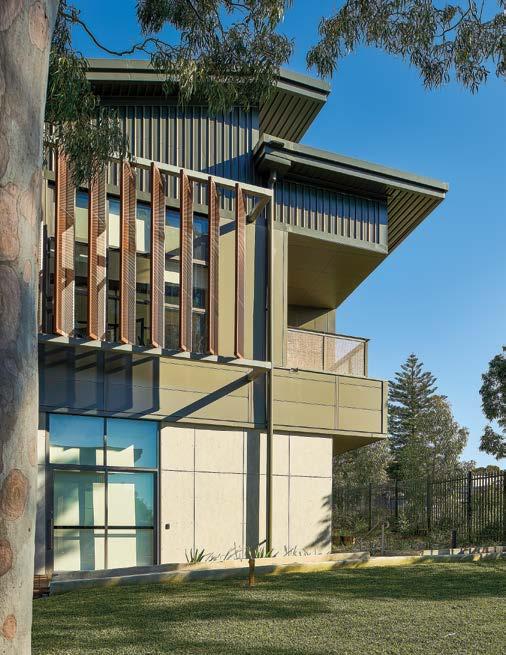

the company with the Australian context of the site.
“The concept has been executed through rigorous technical analysis and thorough cost control, in collaboration with our highlyfocused team of consultants, ensuring that the design will provide a connection to the Black Forest in Schiltach, Germany, whilst conveying the honest and robust nature of the buildings.”
The project was completed in November 2019 and won the 2020 Master Builders Association of NSW Excellence in Construction of Industrial Buildings $15M$20M category for Kane Constructions.


Growth and progress are the key motivators behind Jessie Nasif’s incredible career as a Certification Team Leader at BuildcertSAVAIRA RATUKULA
JJessie Nasif learnt to hold her own from an early age, being the only sister growing up with her siblings.
“I have four brothers and grew up in a maledominated household which meant there was no special treatment for being a girl,” she said.
“We all grew up quite similarly and were active and sporty, which helped me at the dinner table when it came time to defend my food from four hungry boys.”
Her parents migrated from Egypt to Australia, where she was born and raised some 170km north of Sydney in Newcastle.
With five siblings growing up in one household, Jessie’s parents made sure to provide what they could to foster each child’s potential.
“Each of us siblings have immensely different personalities, but a constant throughout our lives have been our parents, who selflessly did the best they could to provide us with opportunities to thrive,” she said.
Jessie’s educational journey kicked off at Wallsend Public School, right through to years 11 and 12 which she spent attending Callaghan College Jesmond.
It was here that she was able to further develop her interests and aspirations.
“During my schooling years, I developed a passion for sports, which became my favourite subject,” Jessie said.
“Engaging in activities such as soccer, AFL and swimming not only fostered physical fitness but also taught valuable lessons in teamwork, discipline, and resilience.
“These experiences were integral to my upbringing, shaping my character and contributing to who I am today.”
Developing her sense of self both at home and in the classroom, life after graduating high school was the next step.
Like most young people trying to figure out their path in life, she was uncertain about what career path she wanted to take after finishing high school.
Deciding to pursue the higher education route, she completed her Bachelor of Construction Management with Honours, at the University of Newcastle in 2015.
She said she was drawn to construction management after she’d heard positive feedback about the degree and the various opportunities it offered.
“Although I initially lacked in-depth knowledge about the field, I was intrigued by its potential,” Jessie said.
“My decision to pursue this career was influenced by the promising prospects it presented, (especially) while working at Buildcert and being surrounded by supportive people.”
Before joining the Buildcert team, Jessie held various positions where she attained valuable transferable skills.
While gaining retail experience at both Tarocash and Zu shoes, it was her job at KFC that allowed her to develop valuable soft skills.
“My initial job was at KFC Jesmond, where I learnt the significance of hard work, resilience, and the importance of managing time and finances,” Jessie said.
“These experiences offered valuable insights and
skills that have been instrumental in shaping my professional journey.”
While at university, Jessie also worked at a shoe shop as part of a 12-week work placement requirement for her construction management degree.
It was here that a colleague at the shop happened to come across a job advertisement at Buildcert.
“I forwarded my resume, went for an interview (and) made a great first impression tripping over my own feet; I initially didn’t get the job but I like to think they came to their senses,” Jessie said.
“However, there is an unsubstantiated tale that the desired candidate had not turned up to their first day — unintentionally, shaping the next 10 years of my life.”
Jessie’s decision to join Buildcert was a significant one given its reputation and potential for growth within the company.
“They chose me (and) we haven’t looked back ever since. No, in all seriousness, the decision to join Buildcert was a significant one for me,” she said.
“It presented a remarkable opportunity to enter the industry I had been studying for over the last five years at university.
“At the time, Buildcert was a small company with just five employees, fostering a close-knit, familylike atmosphere. Everyone was highly motivated to learn, grow, and succeed.”
Buildcert was formed in 2012 and has since become a leader in building approval and certification.
It is backed by a team of professional building consultants and private certifiers, who bring extensive trade backgrounds, local government experience and expert knowledge of the building industry’s legislative requirements.
Their expertise helps provide clients with clear guidance and practical solutions to get projects started and completed faster.
“The position offered was in administration, with promising prospects for advancement into certification or technical roles, which appealed to my aspirations for growth and progression,” Jessie said.
“Buildcert has turned out to be a decision I’m glad I made, and our journey together has been marked by consistent progress and success.”
Since joining the team in 2014, Jessie’s aspirations for growth and progression have been realised through the various roles she’s held within the company.
From 2014 to 2016, she progressed from receptionist to administration officer, which required extensive training all provided internally by the staff.
“Throughout my tenure in this role, I received
unwavering support and guidance, enabling me to tackle new challenges with enthusiasm,” Jessie said.
“I willingly embraced every aspect of the certification administration office role, consistently saying yes to new opportunities for growth and learning.”
This led to the start of her journey as an A4 certifier in December 2016, which immediately followed the completion of her university degree in 2015.
She was an A4 certifier for two years, and had to undergo a short course to obtain her accreditation. During that time, she received training from colleagues within the business and from external seminars and conferences.
A “standout moment” in her career came in 2018 when she achieved her A3 certification position.
“This achievement holds particular significance for me as it marked the culmination of years of hard work and the validation of the knowledge I had acquired,” Jessie said.
“It had a profound impact on me, signalling my capability and opening doors to opportunities such as leadership roles and staff mentoring.
“Overall, it was a pivotal moment in my professional journey.”
To achieve this status, a comprehensive application showcasing your skills, knowledge, and experience needed to be submitted, reviewed and approved by the accredited body, Jessie said.
“To remain current in my field, I actively participate in continuing professional development (CPD) seminars, such as AAC annual conferences, AAC EPIC, and training sessions conducted via webinar,” she said.
“These engagements ensure I stay abreast of the latest industry trends and regulations, equipping me to offer valuable insights to my team.
“As a certifier, it is imperative to stay updated on legislative changes and Building Code of Australia requirements, which evolve continuously.”
Jessie has also fulfilled the role of Acting Client Experience Manager, and was tasked with overseeing and directing residential and commercial administration teams for 12 months.
“Throughout this time, I benefited from guidance and training provided by experienced leaders who had previously held the position,” she said.
“The support within this aspect of the business was exceptional, particularly noteworthy as many of the administrative staff were young women new to the industry, a fact that I found both encouraging and inspiring.
“I even had the opportunity to mentor a few of them towards certification.”
For the past couple of years, Jessie has been “honoured” to hold the position of team leader at
Buildcert where she’s led a team of 14 certifiers.
“This role has not only increased my duties but also provided me with the opportunity to support the progress and advancement of my peers,” she said.
“Being a certification team leader has been a source of inspiration for me, particularly as a woman in the industry, to demonstrate that such achievements are attainable, especially with the backing of those who recognise your potential.”
As part of her training for the position, Jessie participated in an extensive 40-week leadership course with other leaders at Buildcert.
“This experience has been incredibly valuable, enabling me to enhance my leadership skills and gain a deeper understanding of my leadership style,” she said.
“Engaging in this leadership course has expanded my perspective, highlighting the significance of appreciating and understanding every aspect of the business, as well as each team member individually.”
Over the course of an accomplished career, Jessie has been surrounded by an incredible support network.
With her passion for building deep relationships, she said she was fortunate to have these both in her personal and professional settings.
“A constant over the almost past 10 years has been my fiancé who has been my biggest supporter, and motivates me to always grow and be the best person that I can be for myself and those close to me,” she said.
“Professionally, Kaine Tarlinton has been influential for the way he has grown Buildcert and for his humble management style where the success has not changed him. Moreover, I am inspired by the drive and passion Kaine has for the industry and the initiatives he has led across a wide range of services.
“My current manager Daniel Chapman has been similarly influential for nurturing my strengths, providing leadership opportunities, and for often being on the receiving end of my direct and unfiltered feedback that he always takes constructively. I appreciate his wide range of knowledge and life experiences, and most of all his positivity and passion for people.
“In more recent years, I have been very fortunate to meet Zahra Hamed, a truly inspirational young lady who is immensely knowledgeable, passionate, and hard working. We have been working closely together in the same team for the past two years and I hope I have been as positive of an influence on her as she has on me.”
A big influence for Jessie, both personally and professionally, has been Meegan Kelly who was one of the first Buildcert employees and an accredited certifier.
“Having such a female role model was probably the biggest factor in shaping my career path as Meegan
not only demonstrated what is possible, she also actively invested, trained, and inspired me to achieve similar,” Jessie said.
“At that early career stage, the example Meegan set and the support she provided gave me confidence and direction.
“There are many more influential figures in my professional life, but a specific mention to Dane Ceccato who is the Building Code of Australia in human form and is always willing to share his knowledge.”
While crushing it at work, carving out some time for yourself is a very important self-care routine and for Jessie, prioritising activities that help her unwind and recharge outside of work offers her some wellearned downtime.
“I enjoy engaging in hobbies such as culinary construction (cooking) and culinary demolition (eating), reading, exercising/being outdoors, and spending quality time with my fiancé, family, and friends,” she said.
“These activities not only provide relaxation but also offer valuable perspective and inspiration that I bring back into my professional endeavours.”
Celebrating her 10th anniversary with Buildcert this year, Jessie said an aspect of the job that she cherished the most was the opportunity to work alongside her colleagues.
“Observing the growth and advancement of individuals within their roles brings me genuine happiness,” she said.
“I’m motivated by the chance to give back and be a mentor, particularly to younger female professionals, guiding them towards achieving their aspirations.
“This sense of purpose drives me to be a positive influence and role model in the workplace.”
While women in construction only make up a small percentage of the workforce, the last couple of years has seen a more concerted effort to encourage more women to join the industry.
With a well-established career under her belt, Jessie offers several pieces of practical advice for women coming through the construction industry.
“I encourage fellow women in the construction field to approach their roles with confidence and resilience,” Jessie said.
“Refuse to be hindered by stereotypes or prejudices, explore the myriad opportunities available within this industry, dedicate yourself to continuous personal growth and seize every chance for advancement, whether through education, mentorship, or networking.
“Cultivate meaningful connections with supportive colleagues and allies who share your career ambitions. Recognise the significance of your contributions as they play a pivotal role in shaping the industry’s future.”

• Explore the myriad opportunities available within this industry
• Dedicate yourself to continuous personal growth
• Seize every chance for advancement, whether through education, mentorship, or networking
• Cultivate meaningful connections with supportive colleagues and allies who share your career ambitions
• Recognise the significance of your contributions, as they play a pivotal role in shaping the industry’s future
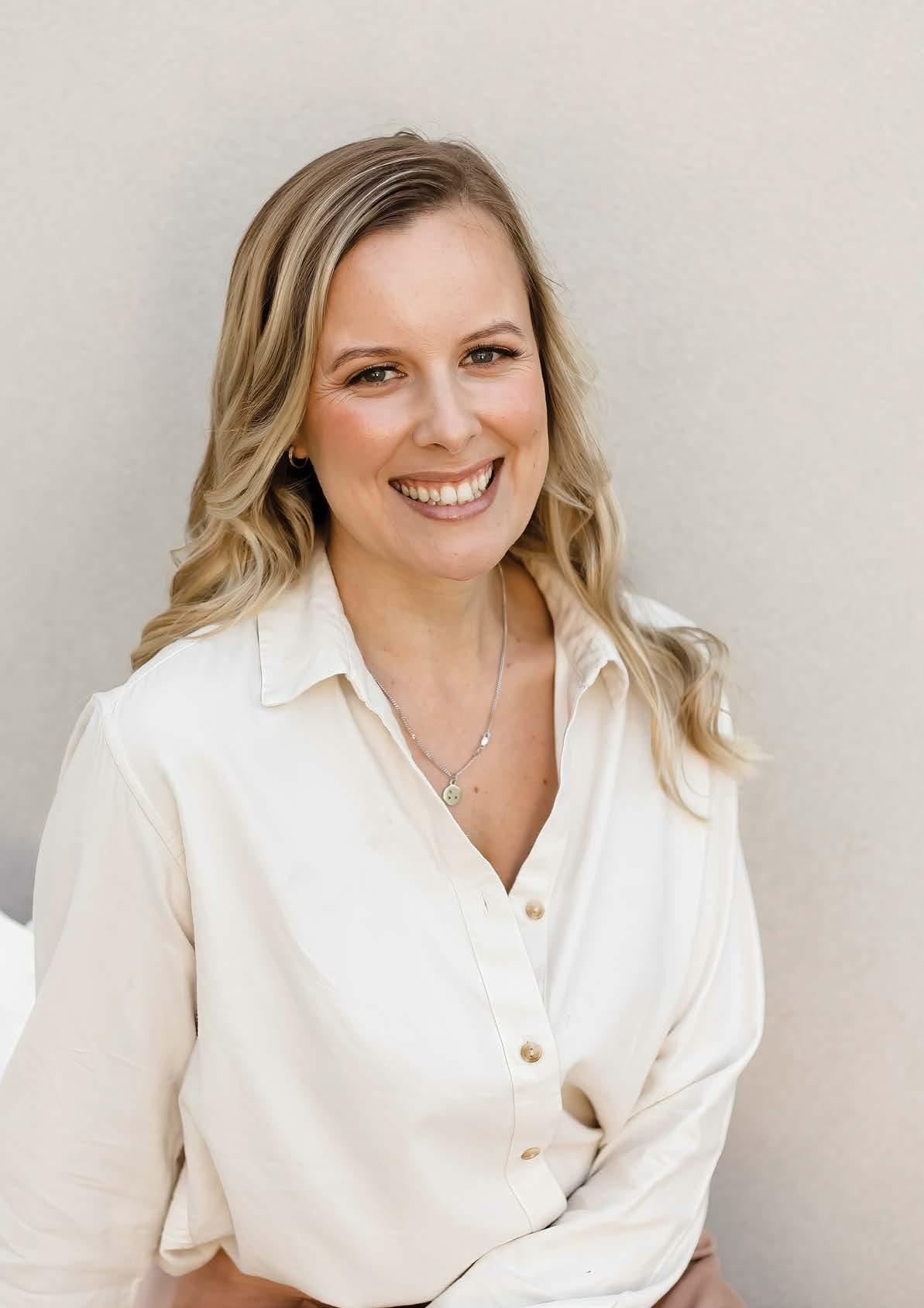
Tell me a bit about yourself and your family?
Iam a 35-year-old mum to one gorgeous, strongwilled toddler, Quinn. She is my miracle child.
Five and a half years ago, in my late 20s, I was confronted with a cancer diagnosis. It threw me. There was no family history and I underwent a couple of major surgeries to remove it followed by three months of chemotherapy. For me, life stood completely still. My boyfriend (now my husband) was an absolute rock and is my biggest cheerleader!
Coming out of this experience, I was determined to do what I could to prevent cancer from returning. I suddenly learnt that our indoor environment can make us sick. I thought this was wild! But we spend on average 90 per cent of our day indoors and sometimes our indoor environment can be more toxic than outside.
Mould is the largest contributor to poor indoor air quality and, recalling a rented apartment that I once lived in that was riddled with mould, I decided that this was where my next chapter would begin.
I studied to become a mould testing technician at the Australian College of Environmental Studies and I am now furthering my studies to become a qualified building biologist.
Tell me about your business?
I help homeowners improve their indoor environmental health thorough mould testing and consultation services.
The service I provide is comprehensive and involves a pre-consultation home history and occupant health history questionnaire. A home mould and moisture assessment can then take anywhere from
3-6 hours to complete depending on the size of the home. The inspection will include air quality analysis, visual inspection, thermal imagery, moisture detection techniques and microbial sampling. Postassessment, a detailed report of the inspection is prepared along with recommendations for the client to return their home to a normal mould ecology and advice on how to prevent mould from occurring in the future.
The mould industry is unregulated (for now) in Australia. As an independent mould testing technician, my advice is solely based on the clients’ requirements, there is no bias. Why is this important? Because my aim is to find and advise on the removal of the source/s of moisture that resulted in the mould growth in the first place. Without this, the mould will likely return and the process of mould removal repeated. Clients can also engage me for post-remediation verification (PRV). This is where I return to inspect and test the client’s home following professional mould removal. Through this process, I will independently assess whether the mould removal was sufficient. It’ll often require the mould remediator to return to the client’s home for further services if the PRV failed.
What’s it like owning and running your own business and juggling family life?
The struggle of the juggle is real. I started my own business to create a greater work-life balance so I could spend more time with my young family. For the most part, I have managed to achieve this but there are times either when it is really busy or worse, when Quinn brings home yet another bug from daycare, when it gets particularly hard. When I worked in corporate, I had a number of sick days I could use and other people to cover my tasks. But as a solo practitioner, it is just me, there is no paid

sick leave and no one else to complete the work for me. I also suddenly learnt that it is so much harder rescheduling a work day with a client than with a boss!
What motivates you?
I love educating people on how to reduce their toxic load through their home environment. As a solo business owner, I still get so excited every single time I get a new client, so much so I text my husband and call my mum!
What advice do you have for other small business owners?
Enjoy it and don’t hold back. I was recently telling someone that starting your own business can be extremely confronting, like all the little areas of business that perhaps you weren’t good at, or avoided in the corporate world you suddenly have to face and conquer in your own business. Those early days are a time of intense personal growth. I recommend finding other people in small business that you can connect with to exchange ideas or experiences and who know what you are going through.

What’s the best piece of advice you received?
Trust in yourself, be authentically you and build your support network!
What’s been your proudest moment as a business owner and personally?
Just recently I was invited to feature in The Mould Festival hosted by Alexx Stuart from The Low Tox Life. As a new business owner, recognition in your profession is a massive achievement!
Do you have any interests/hobbies outside of work?
Family time! Saturday mornings we have a ritual of heading to the local farmers market for brekky with coffee, our little one will play on the playground and we’ll purchase our fresh, organic produce. It really is the small things that bring joy these days!




Apprentice carpenter Candice Arnall is on a mission to help more women in the building and construction industry, and she makes a pretty compelling case!
At 38 years of age, Candice is a second-year carpentry apprentice who decided on a career change. She worked for many years in administration and office-based work. Candice describes herself as being a practical tinkerer, who is always the person on hand to fix things. She
had just never previously considered a trade as a career choice. But after a brief break from her role in administration while she was heavily involved in her home renovations — she began her research into an apprenticeship. Candice found the Master Builders website and decided to register her interest. Within


Toyota Halo connects you to near real-time Fleet visability
Toyota Halo is the latest innovation from Toyota, Australia’s leading fleet vehicle provider. Toyota Halo represents a shift to connected fleet management, using intelligent vehicle telematics to gather data on anything from a few vehicles to a nationwide fleet, providing end-to-end fleet insights from — almost anywhere 24/7.
Toyota Halo gives you a snapshot of where your fleet is* and how it’s performing so you can zero in on ways to enhance efficiency and optimise your business mobility.
Ready to reshape your business with Toyota Halo?
Your Association membership unlocks Toyota Fleet discounts across a great range of Toyota vehicles to help you find the right car for your lifestyle and budget.
To find out more, visit your Toyota Dealer or call 1800 679 247

Scan to sign up for the latest insights from Toyota for Business
1Requires subscription, app installation on compatible mobile device, mobile data, network reception and internet connection. Data usage at user’s cost. Features subject to change. Vehicle requires installation of Toyota Genuine device/hardware with GPS signal and network reception. For details see https://halo.toyota.com.au/tnc
*Uses third party information which may not be accurate or cover all areas

a couple of hours, a Master Builders representative called Candice to discuss apprenticeship options, and the rest is history.
Candice enrolled in the Master Builders’ preapprenticeship program, an entry–level training program that provides an induction to the industry and a carpentry trade prior to commencing an apprenticeship. Within the group of 15, some had never even picked up a tool before. A couple of women in the program agreed that they were waiting for their husbands to fix things around the house so wanted to take matters into their own hands. Some already worked in the industry but wanted to gain hands-on experience. Some participants were school leavers, nervously testing the waters of a potential career in construction.
We asked Candice what she liked about carpentry work. “It’s the energy, the planning, the dirt, and the sweat,” she says. “It’s more than just the result, although that is always a source of immense pride. What I like most is the entire building process from start to finish and looking back at what I have accomplished.”
Because Candice is passionate about women
in construction, she has been identified as the ideal Master Builders representative for the NSW Government-funded Women in Construction Industry Innovation Program. She is taking some time out from her apprenticeship and is on a mission to fulfill the Women in Construction Career Pathways Officer role. Candice is on the road across regional NSW to promote careers in the building and construction industry to high school students, high school careers advisors, job seekers, parents, industry participants, and key stakeholders. And it’s stories like Candice’s that inspire other women to make a start in the industry.
Candice has her eyes set on the future. Once she completes her apprenticeship, she plans on working towards gaining her building licence. Candice plans to start her own construction business and help more women like her make a start in the industry.
If you would like to know more about Master Builders participation in the Women in Construction Industry Innovation Program, visit the website mbaapprenticeship.com.au/women-inconstruction/

“The Australian Dream” used to evoke ideas of a large family and an even larger backyard. The modern Australian dream for young people is currently to make it through the week as financially stable as possible, while trying not to speculate on their rocky future fuelled by the housing and climate crises.
Ideally, contributing to lessening the climate crisis would be a priority, however with no choice but to rent for the foreseeable future, what affordable and renter-friendly changes can be made when choices such as purchasing Solar Panels, are not achievable?

The enormity of the challenge can feel overwhelming, especially given a 2017 study by the Carbon Disclosure Project, which attributed approximately 71 per cent of global greenhouse
gas emissions since 1988 to just 100 corporations. This has left individuals feeling powerless in effecting change.
Despite this, every contribution to change helps — even just for our own conscience. Following is a list of actions everyone can achieve, no matter from which social and economic background they hail.
Conscious Washing: Opt for cold water when washing dishes and clothes to reduce energy consumption and lower power bills. Ensure washing machines and dishwashers are fully loaded to maximize efficiency. This will help to limit the number of microplastics coming off clothes in the wash.
Resist impulse purchases: Wait 24 hours before shopping online, until you know you’re definitely
going to love it, rather than discard it in a few months. If you decide those pants are not for you, save on the carbon emissions of the shipping, as well as the water and energy needed to make the materials.
Conscious Shopping: Prioritise second hand, zerowaste, sustainable, and fair trade products whenever possible from businesses committed to ethically conscious practices, as well as shopping locally where possible. Visit your closest deli or grocer and support a small business rather than the $40 billion large conglomerates under inquiry for price gouging.
Give clothing a second life: Donate or sell your old clothing. Anything too destroyed to go to someone else can be cut up into cleaning rags to keep the material out of landfill. According to the World Wildlife Fund, it takes 2700 litres of water to make one cotton T-shirt. That’s enough water for one person to drink for almost two and a half years.
Installing energy-efficient appliances: When it’s time to replace your appliances such as light bulbs, ensuring they’re LED uses up to 90 per cent less energy and lasts up to 25 times longer than traditional incandescent bulbs.
Eat vegetarian or vegan once a week: The expansion of land for agriculture is the leading driver of deforestation and biodiversity loss. Animalbased foods are more resource intensive, and the amount of energy, water, and chemicals needed to keep livestock is significantly higher than plant agriculture.
Our World in Data Organisation has reported 80
options, don’t give up. Keep trying wherever you can. Educate yourself and keep spreading the word. Our planet needs us.
Microplastics: Extremely small pieces of plastic debris in the environment resulting from the disposal and breakdown of consumer products and industrial waste. An analysis assessing plastic ingestion carried out by University of Newcastle suggests people are consuming about 2000 tiny pieces of plastic every week. That’s approximately 5g a week ingested — the same size as a credit card.
Carbon Offsetting: Compensating for carbon dioxide emissions made by participating in programs designed to make equivalent reductions of carbon dioxide in the atmosphere.
Carbon Neutral: Making or resulting in no net release of carbon dioxide into the atmosphere, especially as a result of carbon offsetting.
Zero Waste: Designing and managing products and processes to systematically avoid and eliminate the volume and toxicity of waste and materials, conserve and recover all resources, and not burn or bury them.
Organic: Farming without the use of chemical fertilisers, pesticides, or other artificial chemicals.
Greenwashing: Misrepresenting the extent to which a product is environmentally friendly, sustainable, or ethical. Watch out for buzzwords like organic and recyclable, and packaging that looks eco-friendly.
Shrinkflation: Reducing the size of a product while


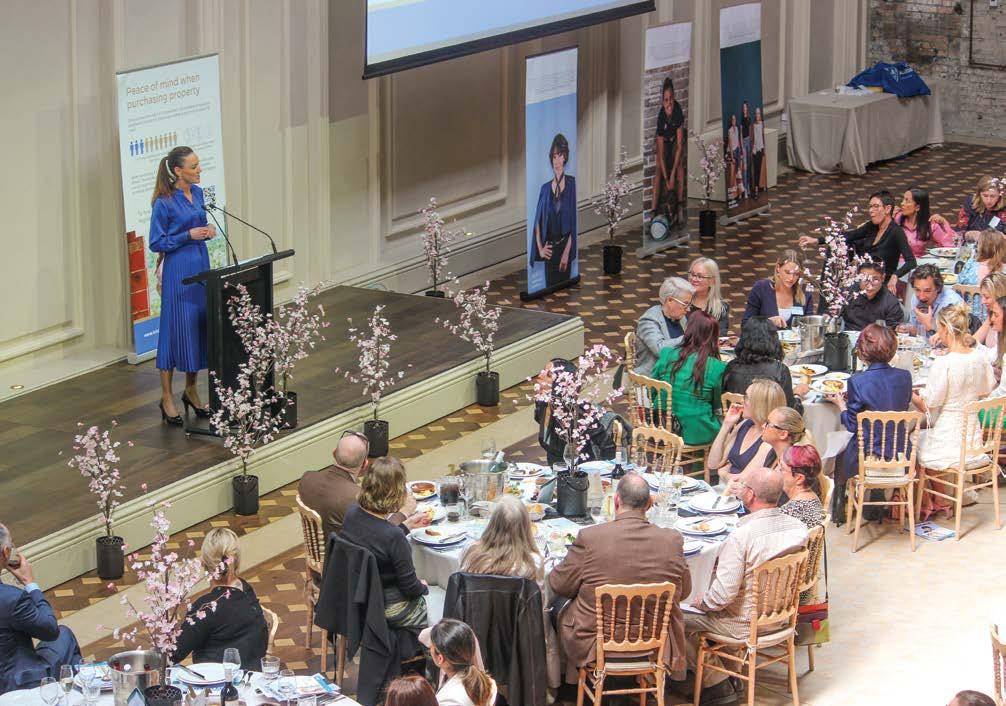


CONSTRUCTING A NEW PERSPECTIVE:
Sydney, 1 September 2023
The Master Builders Association NSW hosted their FLORENCE Luncheon on Friday 1 September, spearheading support for women in the construction industry. The event took place at the magical Eveleigh in ‘The Grounds’. Over 200 guests gathered to celebrate the achievements of women in construction. This event highlighted an affirming and hopeful outlook for the future of the industry.
The event welcomed a diverse group of guests, including, guest speaker Emma Carey author of “The Girl Who Fell From The Sky”, along with representatives from The Office of the NSW Building Commissioner, Safework NSW, and the latest cover star of FLORENCE Magazine, Ava Li from Noble Home Builders.
Emma Carey moved and motivated the audience with her story on surviving a parachute malfunction while skydiving over the Swiss Alps. Having reclaimed the use of her legs through sheer determination after being told she would never walk again. Her words “you will be amazed at what you can adapt to” beautifully illustrating her story. Emma encapsulated her mindset on realising a profound appreciation for life’s every moment, creating a final impact at the luncheon with her quote “If you can, you must”.
The FLORENCE team would be remiss without extending special thanks to the luncheon’s proud partner, Equifax. Alexandra Shaw provided an indepth look at their unique Independent Construction Industry Rating Tool, providing information on qualified builders, and the roll-out of their new Register of Trustworthy Constructors. Anyone can search the register to find a trustworthy building professional, perfect for homeowners, general public, and building a business’ credibility.
Another standout highlight of the luncheon was the exceptional catering provided by The Eveleigh. The large, shared meal plates were a joy to the senses and left the room full of satisfied faces.
FLORENCE is an MBA NSW initiative, helping to construct a new perspective for all those that work in and around the construction industry. The luncheons coincide with two magazine editions a year, where guests can network, and receive a complimentary hard copy of the magazine.
A huge thank you to all who attended this luncheon, and for more information check out the FLORENCE website, www.florenceaustralia.com.au.








Raquel Manning sits down with Gina Field to reflect on her career in the security industry and the ups and downs
As I drive along the M4 to the city of Penrith I’m reminded of the beautiful Nepean river and its famous bridge to bridge. It’s also home to the impressive Western Sydney Conference Centre located in front of the iconic Penrith Panthers venue.
It’s here at a local café amongst one of the Industrial buildings that I chat with Gina Field, the founder and CEO of Nepean Regional Security, gaining valuable insights into Gina’s experiences and journey into the security industry.
In my conversation with Gina there are so many similarities that both of us find as we discuss decades in the field which was sparking a powerful conversation on gender equality in the workplace. In the ‘80s on a bustling building site tensions rose as the union controversially shut down the site upon discovering Gina, a female security
person, was working onsite. Over the years Gina’s resilience and tenacity have been instrumental in challenging the norms and driving change within the security sector.
I asked Gina the following questions;
Can you share with us how your journey started in security and what motivated you to establish your business?
I was working for a large security company, and they made me and my team redundant seven days before Christmas in 1997, it was fight or flight — without any experience I started my own security company in 1998 — January.
You have achieved many milestones in your business career. What remains the most important and why?
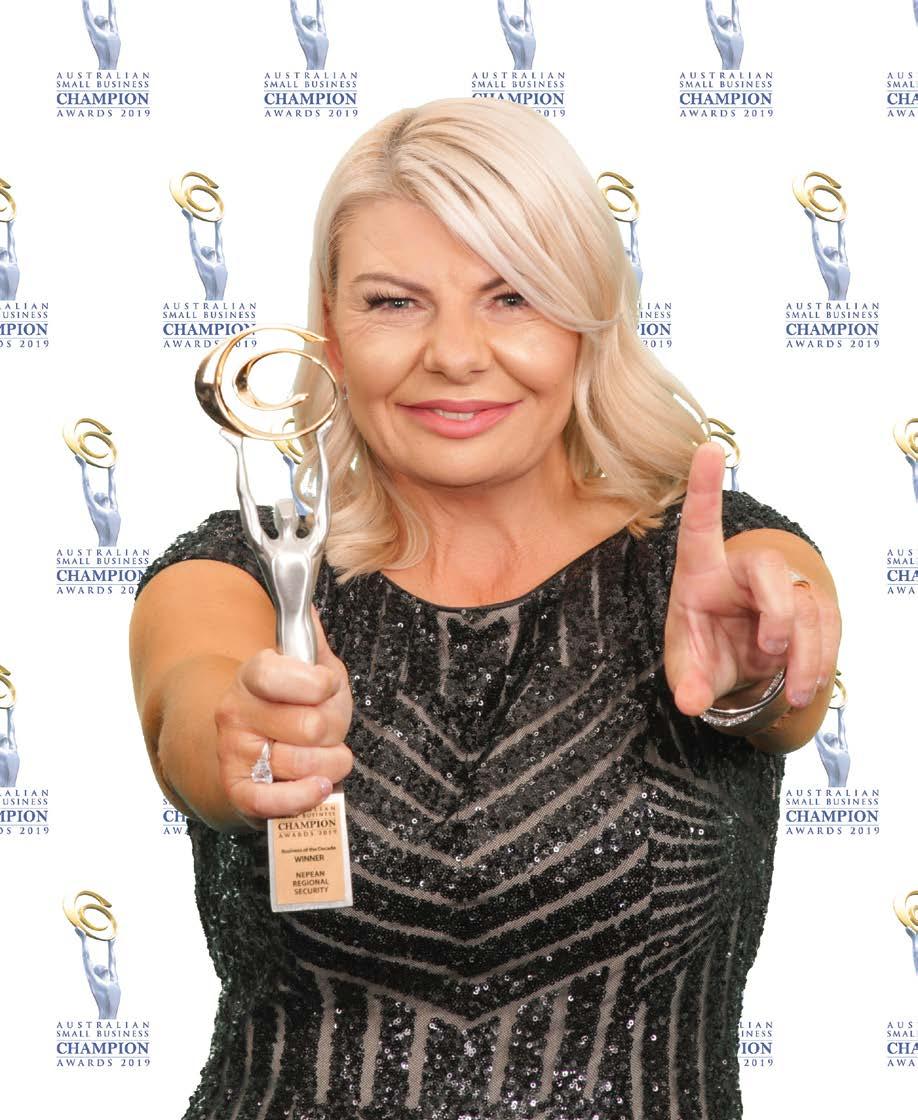
If you are talking about awards, the greatest for me and the most memorable was the day I won NSW Business Woman of the year in 2011 — and I will never forget it being at the town hall in front of 1000 people and I was totally gobsmacked. It was basically my first speech on a stage like that.
I have many things that I live by in business; always lead by example, expansion is not success, keep your finger on the pulse, I control every concept of my business, stay on the tools (staff respect you more), remain humble, give back where you can and always practice what you preach.
Given the essential role that security plays in construction and building sites, how does NRS actively contribute to enhancing security measures both during the pre-construction and post construction phases of projects?
It is really important that we start at the early stages, and the landscape is always ever-changing with building sites which means we have to continually assess the needs of the site, such as solar mobile cameras, physical presence, wireless alarms, mobile patrols. It’s also essential to look at the crime rates in the area and be upto-date with what’s happening crimewise.
How have security measures evolved and changed in the past three decades and what impact have these changes had on the construction sector?
In the ‘80s there seemed a surplus or an endless money pit for the construction sector in terms of building and having a physical presence on site. There was little or no technology back then, so a physical security presence was needed. As technology grows, and margins are extremely tight on projects now, it’s basically a risk-over-reward mentally — do they really need security. We have also been replaced by solar mobile camera towers, and rarely have a physical presence, unless we are checking people in and out at a gatehouse.
Crime for construction sites was not as high in the 80s but at present crime is through the roof and construction sites are being broken into almost (what we are seeing) on a weekly basis — mainly for copper.
In your experience, how have you seen the representation of women in security and what do you think still needs to be done to further promote gender equality in the field?
From when I started, to now, the presence is rising, BUT we still have a very long way to go. There is
still a misconception of women not being able to do what males can. Women are fantastic for defusing conflict situations, appear to have more patience, have amazing decision-making skills, can have more of a calmness in the workplace and also have a more ideological way of thinking in brainstorming. More women are joining higher ranking positions that offer flexible working arrangements and Monday to Friday roles and not so much working on ground level, which to me is extremely sad. It is harder to attract women to roles such as clubs and pubs, which is great due to the conflict resolution skills that they have.
Security is all about unfriendly hours, weekends, nights, Christmas, New year’s — and women still want to be home with their family during those times.
There needs to be more opportunities for women to join security in roles that suit the lifestyle of a family, and more funded opportunities for women to complete security training at a higher level, to be able to fulfil these roles and give to the security section in that capacity.
As a successful business woman, what advice do you have for inspiring the next generation of young women looking to enter a male-dominated industry?
Stay true to yourself. You don’t have to act like a male to be respected. You have to be a little thicker skinned at times, males can be a little direct without consciously thinking about what they are saying, however you need to stay respectful at all times.
It’s okay to speak up — if it’s not okay, it’s not okay. Be quick to set acceptable boundaries, so everyone knows where you are coming from and what your expectations are.

Running a business is not a get rich quick scheme, there is sacrifice of things to get the business off the ground and lots of hard work, long hours, time management and of course the big thing of being organised. I see so many business owners that are so disorganised, and you wonder how they stay afloat.
You will not be a CEO in five minutes. I read yesterday that junior retail workers are applying for 6-figure CEO roles. For some reason there seems to be an extreme disconnect with what hard work is, and what is needed to be successful in any role.
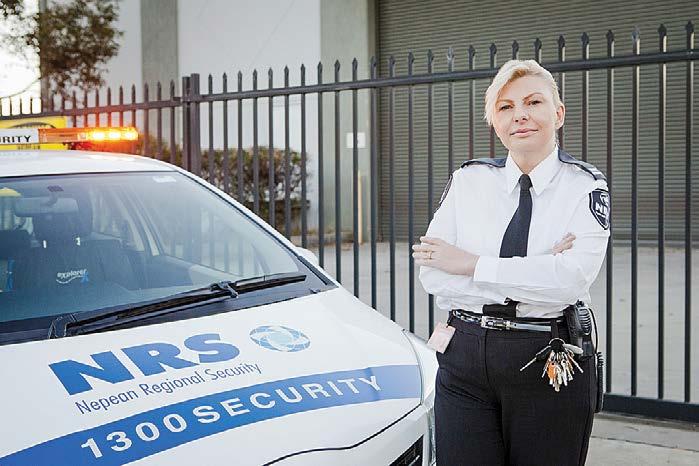
And last but not least, “never say never”. What’s the worst that could happen — you get a NO?
Throughout the years Gina Field has been awarded many prestigious titles. She has been featured on TV, radio, in newspapers, magazines and is a regular guest speaker at functions outlining her courageous journey as a very young female security officer to a successful trailblazing business woman.
 HARE
HARE

In recent years, we’ve seen a remarkable increase in the presence and impact of women in the traditionally male-dominated trade industry. As we celebrate Florence’s 10th edition and reflect on the past five years, it’s clear that women have played a crucial role in reshaping the industry.
Being involved in contributing to Florence magazine from the very beginning has given me the privilege of immersing myself in so many inspiring stories from other women. Their contributions extend beyond their work in the field; they have actively collaborated with their partners, fundamentally changing the dynamics of the trade business.
Additionally, working in the space of supporting wives and partners of tradies who work in the trade business has given me a front-row seat to observe women now stepping into equal partnerships and gaining respect and admiration from their peers and clients.
This shift challenges societal norms and sets the stage for a more inclusive, diverse, and progressive industry. These domestic partnerships aren’t just coexisting in business; they are working as equals, leveraging their unique skills and experiences to drive success while promoting mutual respect and equality.
The success of these partnerships signifies the power of collaborative, respectful alliances that transcend traditional gender roles. The combined expertise of these partnerships is reshaping the industry and challenging conventional family and work dynamics.
As women continue to lead the way in breaking down gender barriers and creating equitable partnerships within the trade industry, I look forward to an even more vibrant, progressive, and balanced professional landscape and can’t wait to see what the next five years will bring!


Name: Kaitlyn Schneider Company: Alder Developments
Position: Assistant Development Manager Phone: 07 5514 4900
Website: www.aldergroup.com.au
WHY DID YOU CHOOSE A CAREER IN THE BUILDING AND CONSTRUCTION INDUSTRY?
My favourite part is seeing the transformation of a project, which is something that you don’t always get in other industries. But mostly, I enjoy the finishes side where you see the project show its identity and character.
WHAT DO YOU LIKE MOST ABOUT YOUR JOB?
I love the variety of what my day can look like because I work on a mix of projects — from master plan communities, land subdivision sites, commercial, marina-based assets — which are all at different stages.
WHAT HAVE BEEN THE CHALLENGES IN YOUR CAREER?
Starting in the industry as a fresh 18-year-old certainly had its challenges from a maturity and experience perspective but working hard and putting in the effort does get recognised and valued by employers.
DO YOU HAVE ANY ADVICE FOR OTHER WOMEN THINKING ABOUT A CAREER IN THE BUILDING AND CONSTRUCTION INDUSTRY?
Go for it! Don’t worry about being the only female on-site because that will change with the work female-led industry groups do. Be confident and don’t be afraid of standing up for what you believe in.

When the nation’s premiers and chief ministers gathered at a National Cabinet press conference in Brisbane on August 16 last year, many of the state and territory leaders looked overwhelmed. They’d just signed up to the latest attempt to solve one of the nation’s longestknown, yet fastest-growing problems — housing supply is not keeping up with demand.
The Prime Minister’s National Housing Accord is a commitment to build 1.2 million, new, well-located homes in the next five years — with a focus on social and affordable housing. On the table, a share of $3.5
billion in federal funding incentives — a money tree all leaders want a piece of. For the leaders standing at that press conference, the monumental size of task of what they had just agreed to, was not lost on them. For newly-minted NSW Premier Chris Minns, there was no illusion something had to be done to get housing moving in the state, but what wasn’t clear, was how he was going to get there.
NSW completed 48,000 new builds. This was behind Victoria’s 59,000 completions — despite a higher population. By early last year, the processing of development applications had slowed to an
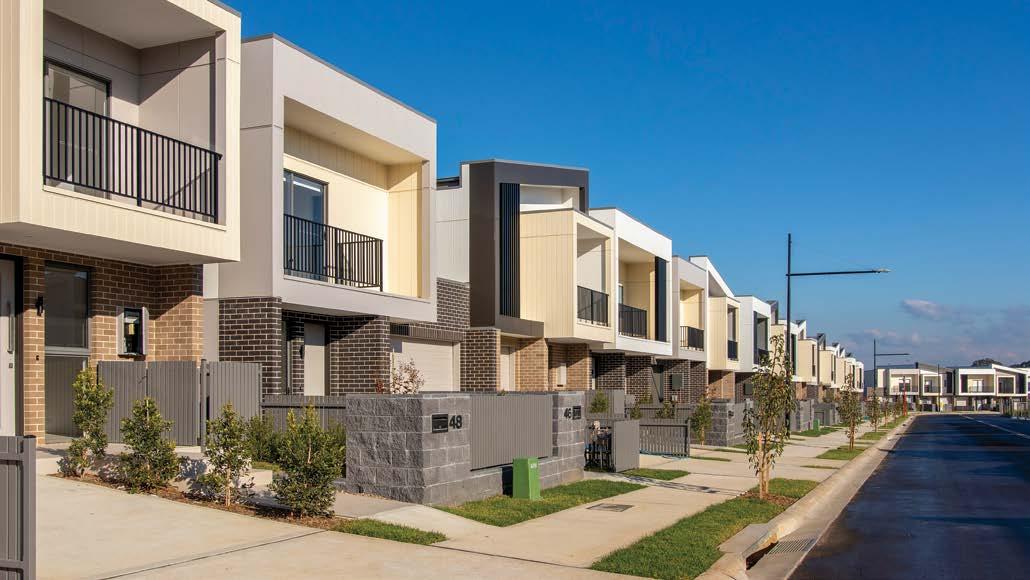

average of four months. Even when new builds do get going, contractors are facing an uphill battle of crippling labour shortages. There just aren’t enough tradespeople to get the job done. This leaves the federal government with a delicate immigration balancing act. Bring enough skilled workers in to ease building site stress, without making the situation worse, by adding more people to the already-stretched housing pool. What both state and federal governments don’t realise is there is an untapped market already here, waiting to be utilised and ready to go.
Women make up 51 per cent of the population but only account for 2 per cent of qualified trade workers. Governments have programs to encourage female participation in construction, but they are largely hidden and poorly marketed. Instead the powers that be need to embark on an advertising blitz, using successful case studies and role models
to push this agenda. Using non-traditional forms of media is imperative, to meet young women where they are the most, on social media. Australia already has world-class tertiary learning facilities and an existing workforce that proves the system works. Imagine what it could be when it is gender equal.
The National Housing Accord presents the goal, but no plan on how to get there. If we are to truly tackle Australia’s housing crisis, for future generations, governments will need to think outside the box. This can be achieved by challenging existing societal norms from the top and encouraging women to not only consider a career in construction, but to actively seek one out. Only then can we talk about seriously addressing labour shortages and, in turn, the housing crisis. Because if only half the population is engaged in building the homes, then we’ll only ever realise half the potential.
As the year shifts into high gear, it often feels like time is in fast-forward mode. Between work, school runs, kids’ sport, and everything else in between, coming up with creative dinners every night is a big ask.
Don’t worry, we’ve got you! These quick and easy recipes are ready in just 30 minutes or less. Full of flavour and made with simple, readily available ingredients, they’ll have everyone rushing to the table in no time.
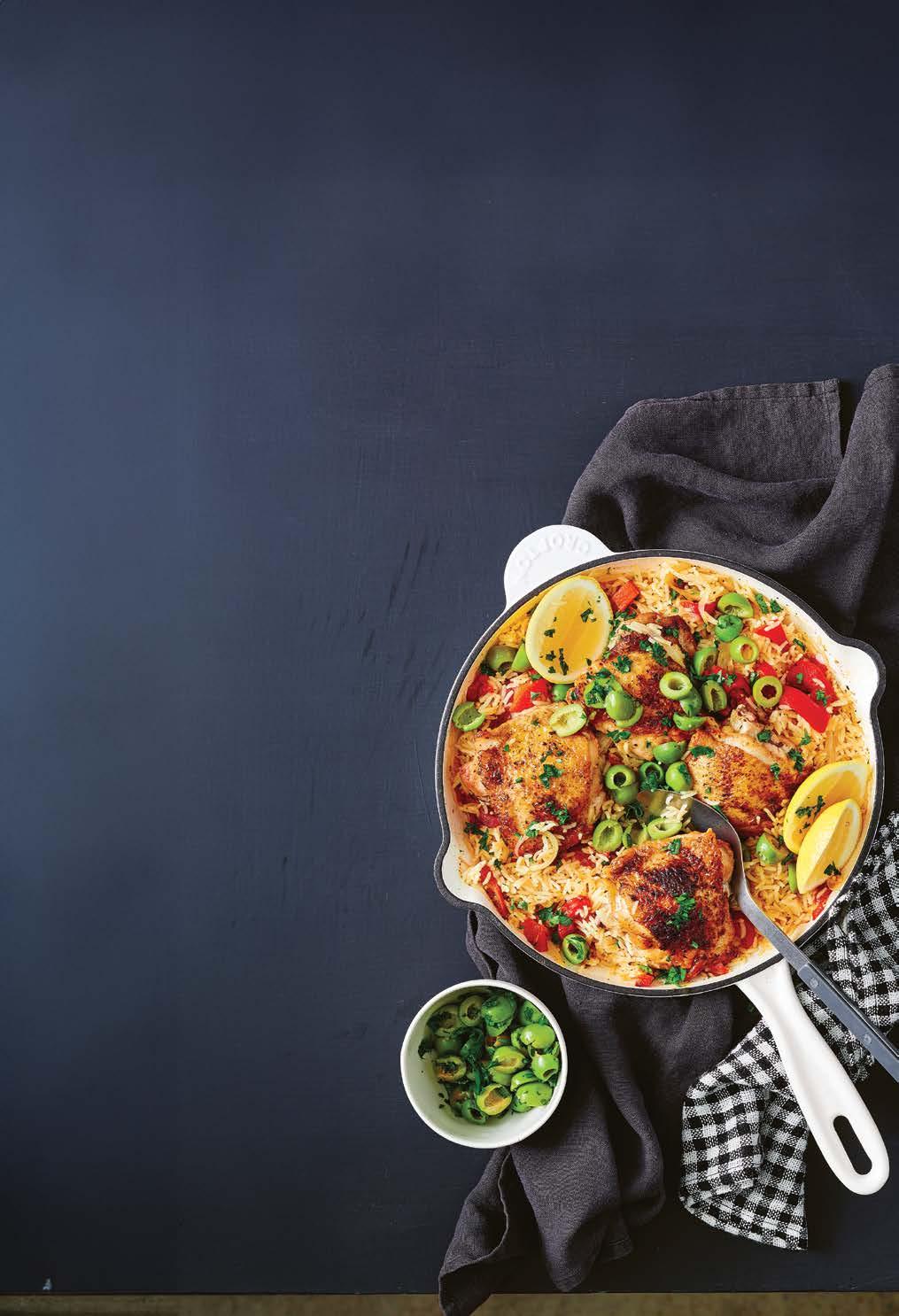


Who doesn’t love a one-pot wonder? With only 10 minutes prep time and three simple steps, this flavour-packed dish will be a family winner.
10m prep; 30m cook; 4 servings
Ingredients
2 tbsp extra virgin olive oil
4 chicken thigh cutlets (skin on)
2 tbsp cajun seasoning
1 brown onion, thinly sliced
1 cup basmati rice
3 garlic cloves, crushed
310g jar roasted red pepper strips, drained
1 Massel chicken stock cube, crumbled
230g jar pitted Sicilian olives, drained, halved
2 tbsp finely chopped fresh flat-leaf parsley leaves Lemon wedges, to serve
Method
1 Heat half the oil in a large, deep frying pan over medium-high heat. Rub chicken with 1 ½ tablespoons of seasoning. Cook chicken, turning, for 7 to 8 minutes or until golden and almost cooked through. Transfer to a plate. Cover to keep warm.
2 Heat remaining oil in pan over mediumhigh heat. Add onion. Cook, stirring, for 4 minutes or until softened. Add rice, garlic and remaining seasoning. Cook, stirring, for 1 minute or until fragrant. Add 2 cups water, capsicum and stock. Bring to the boil. Reduce heat to low. Top with chicken. Cover. Cook for 15 minutes or until rice is tender and chicken is cooked through.
3 Sprinkle pilaf with olives and parsley. Serve with lemon wedges.
Don’t fret over the ingredients list; chances are, you already have most of the staples in your pantry. This dish has the perfect balance of sweet and salty flavours.
15m prep; 15m cook; 4 servings
Ingredients
600g pork loin medallions, thinly sliced
2 tbsp brown sugar
1 ½ tbsp soy sauce
½ tsp Chinese five spice
2 tsp fish sauce
200g packet dried rice stick noodles
1 ½ tbsp vegetable oil
1 red onion, halved, cut into thin wedges
2cm piece fresh ginger, peeled, finely grated
2 garlic cloves, crushed
1 red capsicum, thinly sliced
1 carrot, halved, sliced diagonally
1 bunch baby pak choy, roughly chopped
250g snow peas, trimmed
¼ cup Massel chicken style liquid stock
¼ cup oyster sauce
¼ cup dry roasted cashews
1 green onion, thinly sliced
1 long red chilli, sliced diagonally

Method
1 Combine pork, sugar, soy sauce, five spice and fish sauce in a medium bowl. Toss to coat.
2 Cook rice stick noodles, following packet directions until tender. Drain well. Cover to keep warm.
3 Heat 1 tablespoon of oil in a wok or large frying pan over medium-high heat. Stir-fry pork, in 2 batches, for 1 to 2 minutes or until golden. Transfer to a bowl.
4 Heat remaining oil in wok over high heat. Stir-fry onion, ginger, garlic, capsicum and carrot for 5 minutes or until just tender. Add pork, pak choy, snow peas, stock and oyster sauce. Stir-fry for 2 to 3 minutes or until pork is cooked through and snow peas are tender. Top with cashews, onion and chilli. Serve with rice noodles.

A nutritious delicious rice bowl in minutes? Yes, please!
15m prep; 4 servings
Ingredients
450g packet 2 ½ minute microwave brown rice
300g packet superfood vegetable mix
½ bunch chives, cut into 4cm lengths
1/3 cup Japanese roasted sesame dressing
2 x 150g packets pepper-crusted hot smoked salmon, skin removed, flaked
1 large avocado, cut into wedges
Pepita and sunflower seed mix, to serve
Method
1 Microwave rice following packet directions.
2 Combine warm rice, vegetable mix and half the chives in a large bowl. Add 3/4 of the dressing. Toss to combine.
3 Divide rice mixture among serving bowls. Top with flaked salmon and avocado. Drizzle with remaining dressing. Sprinkle with seed mix and remaining chives. Serve.
This hearty spicy vegetarian dish is great on its own or as an Indian feast served with rice, naan, chutney and pappadums.
10m prep; 20m cook; 4 servings
Ingredients
2 tbsp vegetable oil
1 tsp yellow mustard seeds
1 brown onion, thinly sliced
3 garlic cloves, finely chopped
1 tbsp grated fresh ginger
1 tbsp garam masala
½ tsp turmeric
¼ tsp chilli powder
400g can diced tomatoes
2 x 400g cans chickpeas, rinsed, drained
50g baby spinach, plus extra, to serve
Natural yoghurt, to serve
Lemon wedges, to serve
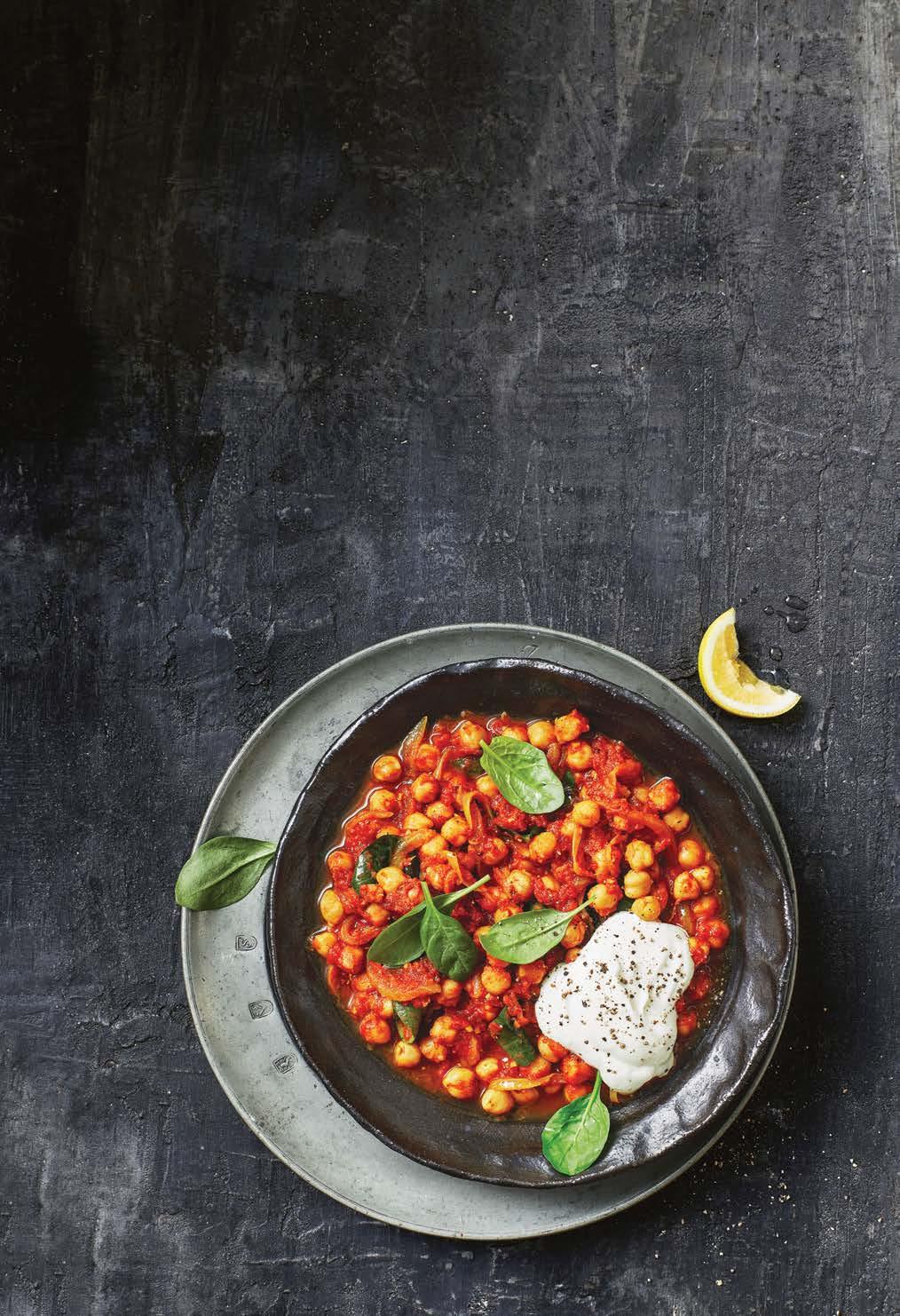
Method
1 Heat the oil in a large saucepan over medium heat. Cook the mustard seeds and onion, stirring, for 4 minutes or until the onion is golden and soft. Add the garlic and ginger and cook, stirring, for 1 minute or until aromatic. Add the garam masala, turmeric and chilli powder and cook, stirring, for another minute. Stir through the tomato and 125ml (½ cup) of water. Cover, reduce the heat to low and simmer for 10 minutes.
2 Uncover and stir through the chickpeas and spinach. Once the spinach has wilted, remove from the heat. Season with salt. Divide among serving bowls. Top with a dollop of yoghurt and a few extra spinach leaves. Serve with lemon wedges.

While sleek, minimal and neutral homes will always be on trend, there’s another style that’s having a moment in a big, loud, colourful way: maximalism. The look loved by designers like Kelly Wearstler and Patrick Mele and embraced by celebs like Zoe Foster-Blake, who debuted her maximalist-inspired renovation in the pages of Vogue Living.
Maximalism is, in a nutshell, ‘more is more’: it’s about creating a space that is bold, eclectic and luxurious. But while it’s about bright colours, funky patterns and cosy textures, it’s definitely not about throwing everything you love into one room and calling it a day: a true maximalist aesthetic means all these things harmonise together in perfect over-thetop excess to create a space that is utterly unique, perfectly balanced and ultimately ‘you’.
But enough about what it is. Here is how you can make it work at your place without it looking like total chaos.
Colour and pattern
Maximalism is all about mixing and matching different patterns and colours in a single space in ways that shouldn’t work… but somehow do. Pair florals with stripes, or purple geometrics with pink polka dots. The key is to keep the atmosphere dynamic and exciting, but not one that clashes. Use the colour wheel to find colours that complement each other or are tonally similar and show them off by using similar shades in contrasting patterns.
Texture is key
If you’re striving for a maximalist aesthetic, don’t be
JENNA MARTIN Simple wooden floorboards and white walls help ground this maximalist living/dining with its feature rug, statement chandelier and pout-red sofa.
afraid to play with texture. Mix materials like leather and fur or velvet and suede to create a look which is layered, visually enticing and most importantly, cosy and warm. A maximalist living room, for example, should never be without a rug on the floor and too many cushions on the couch. Remember, more is more.
Make a statement
While other design aesthetics may advocate for just one statement piece — like an oversized artwork or a luxurious chandelier — with maximalism, you would put them both in the one room and rather than compete for attention, they’d merge together, working in tandem to excite the eye and add whimsy and drama to your space. The aim is to choose pieces you love, that make you happy and bring joy to your room.
Because maximalism celebrates a bit of an ‘anything goes’ approach, it’s the perfect design style to celebrate the old and new and showcase a mix of vintage and contemporary artwork and furnishings. Maybe it’s an antique bar cart alongside a sleek armchair or a 70s shag rug beneath a crisp glass coffee table — the only limitation is your imagination.
Add rugs, pillows and decorative objects to create visual interest, depth and richness to a space. You want to interweave texture, colour and patterns to create a room that feels lived-in but also individual. Maximalism is about carefully curating your room with things you love and not worrying too much

about if they match, more the vibe they create.
With its loud, colourful and unapologetic aesthetic, maximalism is a refreshing alternative to the minimalist trend, giving you a chance to create a space that truly reflects your unique style and character. Bold, eclectic and individual, maximalism isn’t just a design trend: it’s a way of life.
When colour is King and one piece of art is never enough. Pooch not included. Image: unsplash
When it comes to interior trends, Scandi is a look that has been around for awhile now, and it’s a look that is here to stay. But so powerful is its influence, it is sparking off-shoot trends that take the basis of the sleek, minimal and clean design and give it a twist. Right now, there’s no question that the hottest of these trends is Japandi.
If you didn’t know the name, you absolutely know the aesthetic: it’s all over social media. In a nutshell, it’s a blend of Japanese minimalism with Scandinavian warmth.
Simple is key, focusing on warm furnishings, clean lines, mostly neutral colours and natural materials. There’s also a huge focus on sustainability: on buying something well-made and timeless over something trendy and low-quality.
Here’s how to bring Japandi to life at your home, to create a space that is calm, aesthetically pleasing and, most of all, functional.
The calling card of Japandi is minimalism. But it shouldn’t feel stark or clinical. Instead, Japandi is about structured, clean, simple design and functionality, keeping surfaces and spaces clutterfree. If you have a busy household it can be tricky to keep mess at bay, so use storage such as boxes and baskets or — if budget allows — built-ins to hide junk away. In essence, every piece of furniture and decor should serve a purpose, with nothing superfluous or unnecessary.
We’re all familiar with the term “fast fashion”, where clothing is made cheaply, designed to be worn once or twice and then thrown away. In homewares, it’s called “fast interiors” and it is just as wasteful as in the fashion industry, with more and more cheap, broken furniture winding up in landfill once a trend has passed. Japandi is the antithesis of this, with sustainability in design and material one of the
JENNA MARTINhallmarks of the aesthetic. Pieces should be ethically produced and expertly crafted, with longevity just as important as style.
Use wood
Wood is not only a natural, sustainable material making it perfect for Japandi design, it also helps to soften some of the starkness of Scandi and adds warmth to the aesthetic. Wood can be used in the choice of furniture, making a space feel more cosy and lived in, but it’s also often used in the design of rooms as well, with Japandi-inspired spaces often having wooden floors and wooden slatted walls, room dividers or features, like in a bedhead.
While wood is a hallmark of Japandi design, the aesthetic is full of natural materials in general. Stone, paper, cotton, rattan — none of these would be out of place in a Japandi-inspired home. The key is to keep things as simple and sustainable as possible.
Muted colours
While wood is used to create warmth, the rest of the Japandi colour palette is typically muted and understated. Think soft neutrals like white, beige,
and grey dominating the space and enhancing the calm atmosphere. Japandi isn’t totally without colour — it’s just that colour should be introduced through carefully chosen accents like textiles, artwork or furniture.
Embrace texture
Japandi brings together the elegant minimalism of Japanese decor with the warmth and cosiness of Scandi design and one of the best ways to embrace this is through texture. Think boucle, leather and ceramics: you want textures and pieces which will soften the more architectural, functional elements of the design while still maintaining a space that is completely zen.
Bring the outside in
A big thing that Scandi and Japandi have in common is incorporating nature and greenery into the home. Whether that’s through large windows and natural light in the living areas to catch glimpses of trees, gardens or courtyards or through bringing plants into the home, greenery is a big part of Japandi style.


This green couch is a bold pop of colour in an otherwise muted, Japandi-inspired living room.
This light and bright Japandi-inspired kitchen combines clean lines with wooden accents to really nail the aesthetic.
 Wood is used throughout this traditional Japandi-style bedroom.
Wood is used throughout this traditional Japandi-style bedroom.

In the realm of construction, where tradition often reigns supreme, a new wave of talent is emerging, challenging stereotypes, and reshaping the industry’s landscape. Among these rising stars stands Ellsie Mead, a beacon of inspiration whose journey embodies resilience, determination, and a relentless pursuit of excellence. As the recipient of the prestigious Master Builders Australia 2023 National Apprentice of the Year award, Ellsie’s journey is not just one of personal achievement but a testament to the evolving landscape of the industry.
Ellsie’s path to prominence wasn’t paved with ease. As the daughter of industry stalwarts, she could have easily coasted on familial connections. Yet, from the outset, Ellsie set her sights on carving her own legacy, showcasing a remarkable blend of self-reliance and dedication, propelled by an unwavering passion for carpentry. Her performance, as noted by Master Builders Australia’s judging panel, was exceptional in every aspect. Confidence, passion, and eloquence were not mere attributes but defining characteristics that set her apart from the other nominees vying for the 2023 National Apprentice of the Year title.

“I entered my apprenticeship with a really positive mindset,” Ellsie reflects. “I wanted to be a carpenter, and I wanted to be successful.” This determination proved pivotal as she navigated the challenges of being the boss’ daughter, a hurdle she overcame with grace and grit. One of Ellsie’s most striking qualities is her profound industry knowledge. Her decision to upskill and pursue the WHS Cert IV underscores her commitment to continuous learning and pursuit of excellence . Her journey was not only about mastering her craft but also about challenging norms and paving the way for future generations. But it’s not just about qualifications; Ellsie’s understanding of the industry is comprehensive and forward-thinking, positioning her as a leader among her peers.
“I was the first girl,” Ellsie recalls, reflecting on her early days in the trade. “When Georgie, our second female apprentice came along, it was just natural. Everyone accepted it.” Indeed, Ellsie’s presence has catalysed a shift in attitudes within her workplace, fostering an environment where diversity is not only embraced but celebrated. Her ascent has not only shattered glass ceilings but also paved the way for others to follow suit.
“My proudest moments are when we welcome new apprentices,” Ellsie shares. “Especially when one of them is a female. It’s a testament to how far we’ve come.” Beyond her undeniable skill with a hammer and saw, Ellsie’s impact transcends the confines
of her trade. As a confidante and mentor, she has become a trusted ally for her colleagues, fostering open dialogue and driving positive change within the industry.
“The conversations have changed,” Ellsie notes. “The impact women can have is irreplaceable.” Looking to the future, Ellsie sees endless possibilities within the construction industry, where the path from apprentice to leader is well-defined for those willing to seize it. “The opportunities are never-ending,” she asserts. “The transition from trade to managerial roles is paved out for you. If you want that natural progression, it’s there, and you can take it.”
Ellsie Mead is more than just an apprentice of the year; she is a trailblazer, a leader, and a visionary. Her journey serves as a testament to the boundless potential within us all. Through her tenacity, passion, and unwavering commitment to excellence, she has not only earned accolades but also inspired a new generation of trailblazers to defy expectations and forge their own paths.
In the story of Ellsie Mead, we find not only a tale of triumph but also an example where tradition meets innovation, and barriers crumble in the face of unwavering determination. As construction evolves, so too does its cast of characters, with Ellsie Mead joining a rising cohort of strong women in the industry.
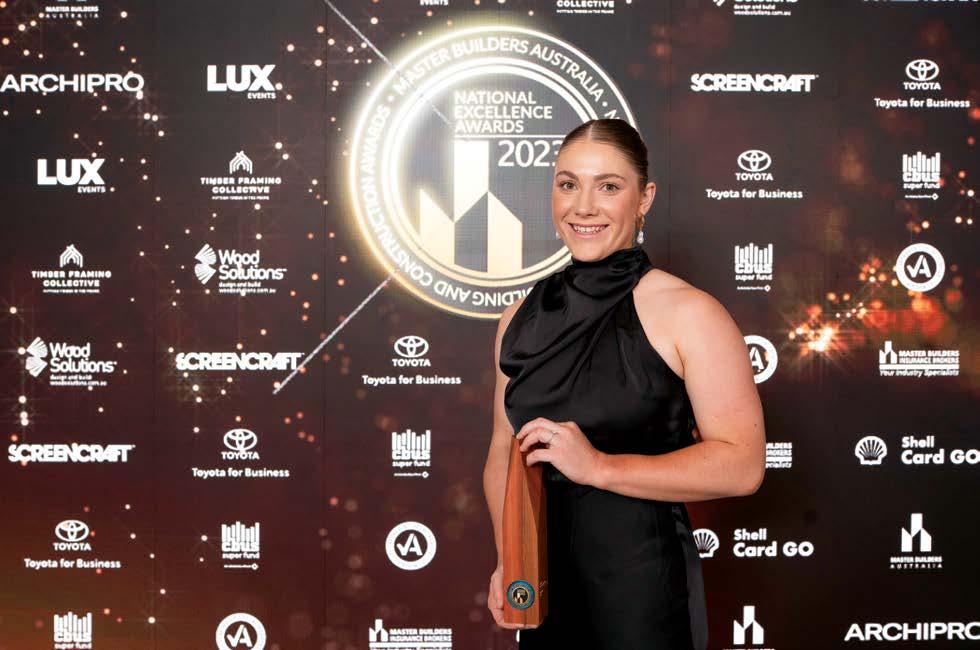

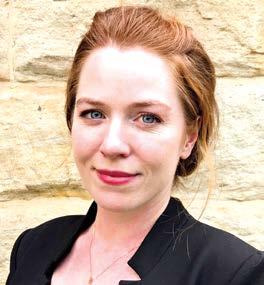

HS: How long have you been involved in the legal and construction industries?
CP: I completed my law degree in the UK in 1985, did my “articles” (practical legal training) in London from 1989 to 1991, and was admitted in the UK in 1991. I then arrived in Australia in 1995 and was admitted as a practitioner in 1996.
I have practised in the area of construction law since 1989. The firm I was articled with had a small construction practice, and mostly disputes. I enjoyed the work and the people so when I came to Australia it was natural to continue working in the area. I worked in a couple of large firms, on large projects and litigation, and a mid-tier specialist firm in disputes.
I started my sole practice in 2016, and the rest is history.
HS: What types of matters do you deal with?
CP: I only take on building and construction matters, and mostly on the Beaches, involving sites from Bilgola down to Manly. I work mostly in the residential building area, although sometimes my clients need help with commercial builds. The majority of my litigation is in the New South Wales Civil & Administrative Tribunal, and some in the District and Supreme Courts. Dispute resolution is also a key part of running a matter, as mediation and settlement conferences can prevent costs becoming disproportionate to the original claim.
In some ways I feel I have come full circle because the matters I work on now are very similar to those when I was starting out as an articled clerk. Except now of course I make the decisions as well as doing the work.
HS: What are the “pros and cons” of being a construction lawyer?
CP: It is certainly an interesting industry. My father was an engineer back in the UK and I used to colour code his plans for him by colouring them in by hand when I was young, so I must have had a bit of a keenness for construction from my early days. I think it’s fair to say that Dad was an early feminist and impressed upon me that I need not shy away from industries that appeared to be male dominated.
The industry is generally full of a lot of hard-working and decent people. I find they make great clients.
The downsides are the long hours, the level of detail that can be involved in construction matters, the deadlines, and the fact that everything is urgent in the modern world — this can be rather unhelpful!
Obtaining instructions by way of vast amounts of documentation can also be difficult, particularly where clients do not live in the electronic world that has become increasingly common for the legal profession.
HS: How has being a woman in the law changed since you started out as a lawyer?
CP: When I started out, female lawyers (especially in construction) were a bit of a novelty, and we were known as “women lawyers”. Now I see many more women as construction lawyers. Maybe women didn’t go into construction back in the 90s in the way they do now, as it was seen as a maledominated industry. They might have gone into property or family law or other types of law that were perhaps more “female-friendly” — if I can say that.
One vivid memory is from 1995. I went to a site
Clare Peacock
office to take a witness statement and whilst there was offered the opportunity to view the site from above. When I climbed up a ladder (unfortunately in my skirt and heels) I was wolf-whistled. Would that happen today? Hopefully not. It was also not uncommon for clients to ask me, not the partner or their staff, to make the tea when attending client conferences, even when as a senior associate. That also wouldn’t happen these days I like to think.
Generally, and this is not confined to the gender aspect of the question, there have been significant changes throughout my career with the commencement and development of the Home Building Act 1989 (NSW) and the Building and Construction Security of Payment Act 1999 (NSW), which have been interesting to see.
HS: Have you noticed over the years that women have become more involved in the construction industry?
CP: Of course the answer to this is yes. I see more female construction lawyers. I see more female architects. The change has been particularly in the last 10 years. Sometimes (and I emphasise that this is only sometimes) female lawyers can be easier to get along with — but maybe that comes with age too. I think you learn that a collaborative attitude is often the key to getting the best result.
HS: What is your proudest moment of being a construction lawyer?
CP: I can’t really pick one moment, but I would have to say that I’m proud of creating the Northern Beaches Construction Lawyers. I have run a lot of cases in the last seven or so years and had quite a lot of success in those cases. It’s always a good feeling when you can deliver a positive outcome.
It’s also really gratifying when clients come back for more advice. I am honoured that they trust me with their business.
HS: What has been one of your biggest challenges as a construction lawyer?
CP: Legal and technological developments. Trying to ensure contractors put variations in writing. Where would we be without the undocumented variation?!
HS: What advice do you have for women seeking a career in the construction/legal industries?
CP: For the legal industry, it will sound obvious but you really just have got to know the law. There is no substitute for that. You also have to know the industry so you can understand what your client is telling you, and how all the different players in the construction industry all fit in and work together.
Regardless of being male or female, it’s about being the best lawyer you can be and focusing on the best outcome for your client. It doesn’t matter how the other side is behaving (lawyer or party) — but striving for an excellent result for your client is always the aim of the game. One final word — don’t feel pressured to answer emails straightaway. A considered response is better than a rushed response and could benefit your client and you in the long run.
Hannah Shephard is a solicitor at MBA Lawyers. Specific legal advice should be sought for individual circumstances.
DATE: Friday, June 14
WHERE: InterContinental, Warrane
WHAT: Be inspired and energised by real stories and practical insights from remarkable women. Welcome to the Women & Leadership Australia Sydney Symposium — the must-attend event for leaders of all genders dedicated to driving equity and inclusion in workplaces and beyond. Whether you’re an aspiring leader seeking role models or a seasoned executive looking for the latest leadership insights, this event has been crafted for you. Join us for an enriching and rewarding experience for leaders at all levels.
COST: Early Bird $1095 + GST; Standard $1495 + GST


COST: $33 AUG 30
DATE: Friday, August 30, 7.10am to 8.30am
WHERE: Steps of Sydney Opera House, Bennelong Point, Sydney
WHAT: An hour long walk and talk mentoring session and networking opportunity in Sydney for women at all stages of their careers. The concept is simple: You and up to two other aspiring women spend an invigorating hour walking and talking around Sydney Harbour with an exceptional female mentor. It’s a supportive space to tackle career progression, discuss work worries, workshop challenges and build connections. It’s for any type of career conversation, and for any stage in your career.

DATE: Wednesday, May 8 (9am to 4.45pm)
WHERE: Sibyl Centre, The Women’s College (within University of Sydney), 15 Carillon Ave, Newtown
WHAT: Discover your own brilliant speaking skills in this groundbreaking, popular workshop for women. If your job involves speaking in meetings, at events, or conferences this training is for you. This workshop is led by Catherine McGrath and her communication specialists. The small group setting means training is tailored to individual needs. Attendees build skills for speaking in professional environments such as meetings and conferences. Training is delivered in carousel sessions, working through a range of practical learning units during the day. The day ends with attendees’ delivering their excellent speeches.
COST: $960
WHEN: Friday, August 23
WHAT: This luncheon celebrates women and their achievements, acknowledging gender diversity issues and offering a platform for women to contribute and connect with inspiring and motivational guest speakers.
With two luncheons each year you can get together and help construct a new perspective with us.
To enquire about partnership opportunities, please contact Amanda Kelly at akelly@mbansw.asn.au or 02 8586 3504. MAY 8

A debilitating condition leaves a third of Aussie women in frequent pain. So why have so few heard of it?
LAUREN CHAPLIN FROM NEWS.COM.AU
“Ifinally have an answer for you,” my doctor said as I settle in a chair in her tiny office.
I almost don’t believe her.
It’s been five years since I first sought advice for the crippling periods, pelvic pain, bloating, fatigue and nausea that had left my body perpetually feeling like a beat up punching bag.
Until now, I have been dismissed by multiple doctors and specialists. One told me it “might be PCOS” (it wasn’t), others said it was “just bad period pain”.

I’d read stories of other women experiencing the same types of symptoms and not being able to find a diagnosis. So when the doctor said she had an answer, I felt the relief course through my body as I realised my experience was finally about to be validated.
“Your ultrasound showed that you have adenomyosis,” my doctor said. I stared at her blankly. “What the hell is that?”
The first time I had an adenomyosis flare up, the pain was so bad my partner thought my appendix had burst. Even his attempt to carry me to the car left me in complete agony, forcing me into a ball and leaving me nauseous. We settled for calling a doctor out to our apartment. We were promised a visit within two hours, but no one came.
The next morning, I tried to explain what I’d felt to my local GP. He told me it was “probably just a urinary tract infection” and sent me away with a script for antibiotics. Knowing I had none of the symptoms of a UTI, I went to a different doctor who ruled it out almost immediately.
This GP sent me for a pelvic ultrasound but, when the results were inconclusive, simply said: “I’m sorry, I’m not sure what else I can do for you”.
This trend of disbelief and medical gaslighting followed
through three more GP visits, countless blood tests, another ultrasound, and, finally, a gynaecologist visit that left me in tears.
That appointment began with the insinuation I was overdramatising my pain, quickly followed by an accusation that I wanted “surgery I didn’t need” when I requested a laparoscopy to rule out endometriosis. When I picked up my bag to leave, the parting shot was delivered: “Some women just have pain. We don’t know why. You might have to learn to live with it.”
I lived in pain for three more years, before another GP grew suspicious of my symptoms and sent me for another ultrasound. I wasn’t feeling hopeful, but it finally gave me the answer I needed. Unfortunately, the diagnosis was just the beginning of a long journey to manage the pain.
Often referred to as the “evil cousin” or “evil sister” of endometriosis, adenomyosis is a disease that manifests in a similar way, with cells like those that line the uterus growing where they aren’t supposed to.
In endometriosis, they can be found anywhere outside of the uterus, which can cause severe pain and infertility. In adenomyosis, the cells and their supporting tissue, called stroma, are found within the muscular wall of the uterus.
It’s estimated that around 35 per cent of women have adenomyosis, yet surprisingly little is known about the disease.
While some women don’t experience symptoms, many others report painful periods, heavy or abnormal bleeding, pelvic pain and painful sex. But it doesn’t end there.
“There’s more and more evidence to support adenomyosis’ impact on infertility, and possibly also obstetric outcomes for increased risk of miscarriages,” Dr Samantha Mooney, an obstetrician, gynaecologist, and clinical researcher, told news.com.au.
“It can also have an impact on both spontaneous fertility and IVF success rate. Up to a quarter of people who suffer infertility will have a diagnosis of adenomyosis,” she said.
It’s also extremely common for adenomyosis and endometriosis to go hand-in-hand, with some studies suggesting up to 89 per cent of people with endometriosis also have adenomyosis.
Because women have long had their experiences dismissed, both endometriosis and adenomyosis typically take years to diagnose – such as in my case – which can result in symptoms getting worse.
Perhaps the biggest reason women are struggling to be formally diagnosed with adenomyosis is that specialists can’t form a unanimous decision on exactly what it is.
Originally seen as a disease that affects those over the age of 40 after childbirth, hysterectomies used to be the gold standard in a diagnosis for adenomyosis. As more and more women in their 20s and 30s have been diagnosed, this has become less viable.
Instead, imaging techniques such as magnetic resonance imaging (MRI) and transvaginal ultrasonography (TVUS) are most commonly used to find the disease. However, this isn’t always straightforward either.
“We can’t find agreement yet in the international literature as to exactly what constitutes adenomyosis on ultrasound,” Dr Mooney said.
“There’s a group that published something, think of it as a consensus on how we should report an ultrasound, to say whether or not certain features are there with regards to adenomyosis.
“But even findings from these often, very hightech and skilled ultrasounds, we can’t agree whether they’re absolutely specific to adenomyosis or not.”
It’s the same for MRIs.
No relief
Even once you have a diagnosis, things don’t necessarily get any easier. It took me multiple attempts to find a pain medication that offered me even the slightest bit of relief. Some days, it’s still not enough.
Then there’s the first-line therapy for managing symptoms. Like most conditions that solely affect women, it comes in the form of the contraceptive pill. Once again, this can take a lot of trial and error to find one that works. For those looking to get pregnant, it’s not even an option.
As Dr Mooney points out, there’s also an ongoing cost to it not everyone can afford.
“Only very few of the hormonal remedies that may treat adenomyosis, or at least keep the symptoms at bay, only very few of those are covered by the Pharmaceutical Benefits Scheme (PBS),” she said.
Adenomyosis isn’t even listed on the PBS coverage for some of the medications that we use.”
Some surgical procedures may also be considered for
adenomyosis, with a hysterectomy used as a last resort for those who haven’t responded to any other treatment.
There’s a relief to finally putting a name to your pain. Unfortunately, this relief is snuffed out moments later with the words “there’s currently no cure for adenomyosis”.
Some attempts are being made to improve the diagnostic process, such as a letter submitted this week to the Journal of Clinical Pathology calling for pathologists to form a consensus on exactly how to diagnose the disease.
But if real change is going to happen, we need to start talking about it. Endometriosis is finally starting to get the recognition it sorely deserves.
It’s about bloody time adenomyosis did too.
Medicare is failing women and it’s About Bloody Time things changed. Around one million suffer from endometriosis. There is no cure. Help is hard to come by and in rural or regional areas, it’s virtually impossible. We are campaigning for longer, Medicare-funded consultations for endometriosis diagnosis and treatment.
This article originally appeared on news.com.au and was republished with permission.

When Sarah Roberts struggled to conceive, doctors assured her it was “normal” — but the TV star pushed back, proving “something wasn’t right”.
REBEKAHSCANLAN FROM NEWS.COM.AU
When Sarah Roberts struggled to conceive, even with the help of fertility treatment, doctors assured her it was very common.
But after two miscarriages and five failed embryo transfers, the former Home and Away actress couldn’t fight the feeling it was something more sinister.

“I just knew in my gut that something was wrong, something in my body wasn’t right,” the 39-year-old told news.com.au.
“IVF can be difficult for a lot of people, but I had five genetically-tested embryos, and none of them stuck.
“And I remember, before I transferred the last one, I said to the specialist, ‘there’s something wrong with my body, it doesn’t feel normal to me.’
“It felt like someone had a really sharp knife covered in barbed wire and was stabbing me in the vagina. My insides were in agony.”
The awful pain wasn’t Roberts’ only troubling symptom. She also had unexplained bloating, which became particularly bad during the egg collection stage of her IVF treatment, and had trouble going to the toilet.
But to her surprise, doctors didn’t seem too concerned by her worrying list of ailments.
Undeterred, and after reading about endometriosis — a condition that can affect fertility and cause an array of agonising issues in women — Roberts pushed for a laparoscopy.
A laparoscopy is a keyhole surgical procedure used to diagnose and treat endometriosis by checking for
abnormal deposits of endometrial tissue, scarring or cysts in the reproductive organs and pelvis, and if necessary, removing this tissue.
“I went back to the IVF specialists and said, ‘I don’t care what anyone thinks, I want the surgery,” she explained. “It was a huge risk because there is the potential I could go into the laparoscopy and find nothing. Then I would feel embarrassed and that everyone else had been right. I was terrified people would think I was just being hysterical.”
But she was far from wrong.
In fact, the procedure proved the popular personality — who also works as a DJ — was spot-on with her suspicions.
“They discovered I had stage two endometriosis and it was on the uterus, both of my ovaries and bowels,” she says. “I replied and said, ‘yeah, I told you that six months ago.’
“It was such a funny feeling. On one side, I was so relieved because it was confirmation that I’m not crazy. But I was angry too because I honestly felt gaslit.”
Roberts is not alone in feeling this way. In a news.com.au survey of more than 1700 Australian women who suffer from endometriosis, 54.4 per cent said they had not been taken seriously by doctors and had mostly negative experiences, with 17.3 per cent saying they felt they had never been taken seriously when seeking medical help for endometriosis.
Despite the conflicting emotions around her diagnosis, Roberts says she felt grateful she finally knew she had endometriosis, a common condition that affects one in nine Australian women.

Endometriosis occurs when endometrial tissue, which is similar to that which lines the uterus, grows outside of the uterus — usually in areas like the ovaries and fallopian tubes as well as on organs such as the bladder, bowel, vagina and cervix.
In several extreme cases, it has even been found in the lungs and brain.
Symptoms and severity varies from person to person, but for many it can lead to crippling physical pain. About one in three women who have endometriosis struggle with fertility and find it difficult to get pregnant.
“Even though doctors tell you that miscarriage and fertility issues are very common, it doesn’t help with the pain of what comes with losing a pregnancy,” Roberts explained.
“For a long time during my journey, I never tested for endometriosis, I’d never heard of it actually. It was only after I picked up bits and pieces of information on it that I really considered it might be the cause of my struggles.”
After her diagnosis, Roberts buried herself in research in a bid to understand her diagnosis and the symptoms that affect her on a daily basis.
“At first I was in disbelief, I was convinced there must be a way to fix it,” she says. “I couldn’t accept that it was actually a chronic illness.
“I would read books and listen to podcasts and Google things and, you know, change my diet.
“With every kind of symptom that I got, I was like, oh, no, I better work on that, or there must be a way out of this.
“But it just got so tiring, it took up so much energy and it was exhausting for me.”
These days, Roberts says she has learned to “ride the waves”, admitting that sometimes she will “wash in and out of acceptance and grief”.
“It’s like grieving for the body that I once had, but also accepting that my body has just changed now, and that endometriosis has almost become, this might sound weird, but like my friend,” she says.
“But it’s a friend that you don’t really want to have.”
Although she frequently experiences symptoms, “it’s different every month” says Roberts, explaining that she’s noticed lifestyle factors can cause the condition to flare.
“Stress really impacts me, so I try to do things that are calming like yoga,” she shares.
“Also DJing has me standing for long periods of time and because of that my back gets really sore and then I get that stabbing pain again, but I just have a lot of drugs in my DJ bag, and not the fun kind, you know, just Panadol and Ibuprofen.
“I’ve also noticed if I eat certain things, drink less alcohol, stay off dairy and gluten, it really helps me but also, it’s really boring.
“So I also give myself breaks as well. Sometimes, I just want to have a good time and, you know, go out to a restaurant and not worry.”
Roberts bravely opened up on social media about her condition, finding support and connection with other women who share similar experiences.
“I think I’ve just about come to terms with it now, but it’s still really hard,” the star shared.
“Every single day I have endo belly and as the day progresses, I start to look like I’m pregnant.
“Sometimes, I just pretend that I am pregnant and let it sit there. Or I wear different clothes. I used to wear a lot of tight clothes and I still do at times, but if I’m going out at night for dinner I’ll probably wear something that drops at the waist.”
As for her plans of having a family, she has decided to “put that on ice…literally” for now, but says she is open to exploring other avenues to becoming a parent.
“I just want other women to hear my story and feel inspired and to trust their instincts, there is power in sharing” she added.
“Don’t be afraid to ask questions and push for answers. That’s what I wish someone had told younger Sarah.”
This article originally appeared on news.com.au and was republished with permission.
About Bloody Time is an editorial campaign by news.com.au that been developed in collaboration with scientists recommended by the Australian Science Media Centre, and with the support of a grant from the Walkley Foundation’s META Public Interest Journalism fund.
Medicare is failing women and it’s About Bloody Time things changed. Around one million suffer from endometriosis. There is no cure. Help is hard to come by and in rural or regional areas, it’s virtually impossible.
We are campaigning for longer, Medicare-funded consultations for endometriosis diagnosis and treatment. id=3dfe4d90-d520-11ee-9d1a-6b6d3d7b3212)
Read more about the campaign and sign the petition here (https://www.change.org/p/fighting-for-bettercare-for-those-battling-endometriosis-765356bf-cfbd4fa8-944a-23ea7bd7dae3?utm_medium=custom_ url&utm_source=share_petition&recruited_by_ id=3dfe4d90-d520-11ee-9d1a-6b6d3d7b3212)
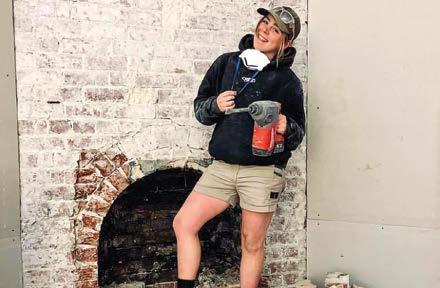
@tryin_to_chip
Brittany 24
3rd year apprentice chippy
Victoria

@bards.builds
Bardie Somerville
Be the change!
Creator of @theshift.au
WINNER: The Bridge AU

@chippychick_hac
Anita Hac
Carpenter Cbr, Aus

@toogood.on.the.tools
Abi Toogood
4th year Chippy Apprentice for D and J
Love the crazy world of building and creating, just here to share it with you all.
Gold Coast, Qld

@sydneybuilderchick
Felicity Pettiford
Carpenter, 21 years. Qualified Chippy & Builder
2024 EWITS Tradie Lady of the Year
Inspiring all women to follow their dreams
Sydney, NSW

@laurathebuilder
Laura Madden
Irish-Canadian Australian girl living abroad at home in Brisbane, Qld
Co-founder @eveworkwear
Despite builders best efforts, leaking showers are consistently listed in the BSA’s top ten defects.
Sadly, sometimes this is due to substandard workmanship, but most of the time it is the design of the shower itself which is creating the potential for disaster.
Most contractors are at a complete loss as to why, but detailed testing has shown how, by the action of expansion and contraction, water is “pumped” along glue cavities to escape the shower enclosure, no matter how well it is water-proofed.
The best way to prevent the problem is to seal the screen directly to the membrane, and NOT to the tiles.
Waterstop Streamline provides:
• Positive connection between screen and membrane
• Maximises floor area
• Provides a template for following trades
• Ensures correct fall to waste
• Complies with and exceeds AS3740
• Modern, cost effective, one-piece design
• 20 different shapes and sizes
• Minimum change for maximum benefits


My business has expanded rapidly since we started using the Waterstop Streamline hob and I now have tilers recommending the Waterstop Streamline system – and me – to other builders. Everyone that uses it loves it.
Mr Fred Meddings, Managing Director Watertight Australia (Water-proofers)
By using Waterstop Streamline I know the shower will be perfect every time. It has to be, because this product is designed to dictate placement of all of the other components to make up a complete shower. It’s virtually impossible to stuff it up.
Mr Glen Whitehead, Managing Director BJM Developments



